Physical Address
304 North Cardinal St.
Dorchester Center, MA 02124
Pathology of the musculoskeletal system 1
1 https://www.niams.nih.gov/health-topics/muscle-bone-diseases . Reviewed April 20, 2017. Accessed January 26, 2019.
ranks first among disease conditions that alter the quality of life. This is related to limitation of activity, disability, and impairment. Musculoskeletal disorders are associated with high costs to employers such as absenteeism; lost productivity; and increased health care, disability, and worker's compensation costs. Musculoskeletal disorders are more severe than the average nonfatal injury or illness (e.g., hearing loss, occupational skin diseases such as dermatitis, eczema, or rash). In the United States, one of every four persons suffers from some sort of musculoskeletal disorder. Here are the facts:
Musculoskeletal disorders account for nearly 70 million physician office visits in the United States annually, and an estimated 130 million total health care encounters, including outpatient, hospital, and emergency room visits.
The Institute of Medicine 2
2 https://www.cdc.gov/workplacehealthpromotion/health-strategies/musculoskeletal-disorders/index.html . Updated March 1, 2016. Accessed January 26, 2019.
estimates musculoskeletal disorders result in an economic burden of $45 to $54 billion annually, as measured by compensation costs, lost wages, and lost productivity.
The Bureau of Labor Statistics reported 26,794 carpal tunnel syndrome cases involving days away from work.
The Bureau of Labor Statistics reported 372,683 back injury cases involving days away from work.
In 2013, the total cost for arthritis conditions was $140 billion. 3
3 https://www.cdc.gov/arthritis/data_statistics/cost.htm . Reviewed February 22, 2018. Accessed January 26, 2019.
Some estimates place the cost around $353 billion.
There are 52.5 million adults with arthritis living in the United States, 30 million of whom have osteoarthritis (OA).
ΟΑ was the second most costly health condition treated at United States hospitals in 2013. In that year, it accounted for $16.5 billion, or 4.3%, of the combined costs for all hospitalizations. 4
4 Torio CM, Moore BJ. Statistical Brief #204. National Inpatient Hospital Costs: The Most Expensive Conditions by Payer, 2013 . Rockville, MD: Agency for Healthcare Research and Quality; 2016.
Persons who are limited in their work by arthritis are said to have arthritis-attributable work limitations. These limitations affect 1 in 20 working-age adults (aged 18 to 64 years) in the United States, and 1 in 3 working-age adults with self-reported, doctor-diagnosed arthritis.
In 2004, the sum of the direct expenditures in health care costs and the indirect expenditures in lost wages has been estimated to be $849 billion, or 7.7% of the national gross domestic product.
Table 20.1 lists some of the more common musculoskeletal disorders.
| Condition | Pathologic Findings | Symptoms | Typical Causes |
|---|---|---|---|
| Bursitis | Inflammation of the bursa between skin and bone, or bone and tendon, occurring at the hip, knee, elbow, or shoulder | Pain and swelling at the site of the injury | Kneeling, pressure at the elbow, repetitive shoulder movements, tight IT Band |
| Carpal tunnel syndrome | Pressure on the median nerve that passes up the wrist | Tingling, pain, and numbness in the thumb and fingers, especially at night | Repetitive work with a bent wrist, use of vibrating tools; sometimes follows tenosynovitis (see later in table) |
| Ganglion | A cyst at a joint or in a tendon sheath, usually on the back of the hand or wrist | Hard, small, round swelling; usually painless | Repetitive hand movements |
| Tendonitis | Inflammation of the area where muscle and tendon are joined | Pain, swelling, tenderness, and redness of hand, wrists, or forearm; difficulty in using the hand | Repetitive movements |
| Tenosynovitis | Inflammation of tendons or tendon sheaths | Aching, tenderness, swelling, extreme pain, difficulty in using the hand | Repetitive movements, often nonstrenuous; can be brought on by sudden increases in workload or by introduction of new processes |
| Tension neck or shoulder | Inflammation of the neck and shoulder muscles and tendons | Localized pain in the neck and shoulders | Having to maintain a rigid posture |
| Trigger finger | Inflammation of tendons or tendon sheaths of the fingers | Inability to move fingers smoothly, with or without pain | Repetitive movements; having to grip too long, too tightly, or too frequently |
Diseases of the musculoskeletal system are divided into two categories: systemic and local. Patients with systemic disease, such as rheumatoid arthritis, systemic lupus erythematosus, or polymyositis, may appear chronically ill with generalized weakness, pain, and episodic stiffness of the joints. Patients with local disease are otherwise healthy individuals who suffer restriction of motion and pain from a single area. Included in this group are patients suffering from back pain, tennis elbow, arthritis, or bursitis. Although these patients may have only local symptoms, their disability can greatly limit their work capacity, and the disease can have a severe effect on their quality of life.
Diseases of the musculoskeletal system rank first in cost to workers’ compensation insurance carriers. Nearly 100,000 workers receive disability payments annually, with a total cost greater than $200 billion annually.
It has been estimated that musculoskeletal problems rank second (after cardiovascular disorders) in accounting for visits to internists and third in terms of surgical procedures in hospitals (after gynecologic and abdominal surgery). According to a Gallup poll in 2014, 5
5 https://www.prnewswire.com/news-releases/new-survey-reveals-majority-of-americans-suffer-from-foot-pain-259775741.html . Reviewed May 14, 2014. Accessed January 26, 2019.
77% of individuals older than 18 years complained of foot pain at some time. More than $300 million is spent annually on insoles, corn remedies, bunion removers, other foot care products, and over-the-counter medications for foot care. Despite this widespread problem, less than 50% of clinicians know how to examine a foot correctly.
Although usually nonfatal, musculoskeletal conditions can significantly affect the quality of life. Studies indicate that backache is experienced by more than 80% of all Americans at some time in their lives. Patients with backache for longer than 6 months constitute a large portion of permanently disabled individuals. More than 50% of these patients never return to work. More than 25 million Americans suffer from arthritis that necessitates medical attention. Arthritis ranks second to cardiac disease as a cause of activity limitation. Table 20.2 lists the most common musculoskeletal disorders in adults aged 45 years or older in the United States.
| Extremely Common (Prevalence >5%) |
|
| Common (Prevalence 0.5%–5%) |
|
In the United States, at least 10% of the population experiences a bone fracture, dislocation, or sprain annually. Women older than 50 years sustain over 1.2 million fractures annually. There are more than 200,000 hip fractures annually, and these are associated with prolonged disability and significant mortality at 1 year. Age-related fractures are projected to increase nationally from 2.1 million in 2005 to over 3 million fractures in 2025, solely on the basis of growth in the elderly population most at risk. 6
6 Burge R, Dawson-Hughes B, Solomon DH, et al. Incidence and economic burden of osteoporosis-related fractures in the United States, 2005–2025. J Bone Miner Res. 2007;22:465.
Osteoporosis 7
7 Osteoporosis is a state of decreased density of normal mineralized bone.
is the most common musculoskeletal disorder in the world and is second only to arthritis as a leading cause of morbidity in the geriatric population. Postmenopausal osteoporosis and age-related osteoporosis increase the risk of fractures in the older population. There are more than 40 million women in the United States over the age of 50 years, and more than half of them have evidence of spinal osteoporosis. For women older than 75 years, 90% have significant radiographic evidence of osteoporosis.
The high prevalence of musculoskeletal disease in older adult patients who require assistance has a significant effect on the American economy. The annual cost of nursing home care for patients with musculoskeletal disease is approximately $75 billion. More than 10 million individuals in the United States have some form of inflammatory arthritis, with rheumatoid arthritis being the most prevalent at around 7 million.
Musculoskeletal problems have the most significant financial effect on the aged population. Medicare spends more than $1 billion annually for hospitalization of patients with these conditions. This represents 20% of all Medicare payments.
The principal functions of the musculoskeletal system are to support and protect the body as well as bring about movement of the extremities for locomotion and the performance of tasks.
The parts of the musculoskeletal system are composed of variable forms of dense connective tissue, which include the following:
Bone
Skeletal muscle
Ligaments and tendons
Cartilage
Bone is composed of an organic matrix that consists of collagen fibers embedded in a cementing gel made up of calcium and phosphate. Bone is an actively changing tissue with constant remodeling while reappropriating its mineral stores and matrix according to mechanical stresses. Normal bone is composed of collagen fibers aligned parallel to the tension stresses to which the bone is exposed. The long bones in adults are composed of tubes of cortical, or compact, bone surrounding a medullary cavity of cancellous, or spongy, bone. Cortical bone exists in areas where support is necessary, whereas cancellous bone is found in areas where hematopoiesis and bone formation occur. In cortical bone, the bone cells, or osteocytes, are enclosed in lacunae, which are spaces in the sheets of bone tissue called lamellae. Several lamellae are arranged concentrically around a vascular channel and are termed a haversian canal. In cancellous bone, the lamellae are not arranged in haversian systems but are organized into a spongy network called trabeculae. These trabeculae align along lines of stress.
The ends of the long bones, called epiphyses, are expanded near the articular surfaces and are composed of spongy bone. The shaft of the long bone, the diaphysis, is covered with a layer of periosteum. The inner cavity of the long bone is lined with endosteum and is filled with marrow.
For a time, a layer of cartilage exists between the diaphysis and the epiphysis. This cartilage is known as the growth plate or epiphyseal plate. The purpose of the growth plate is to determine the longitudinal growth of the bone. The parts of a long bone are illustrated in Fig. 20.1 .
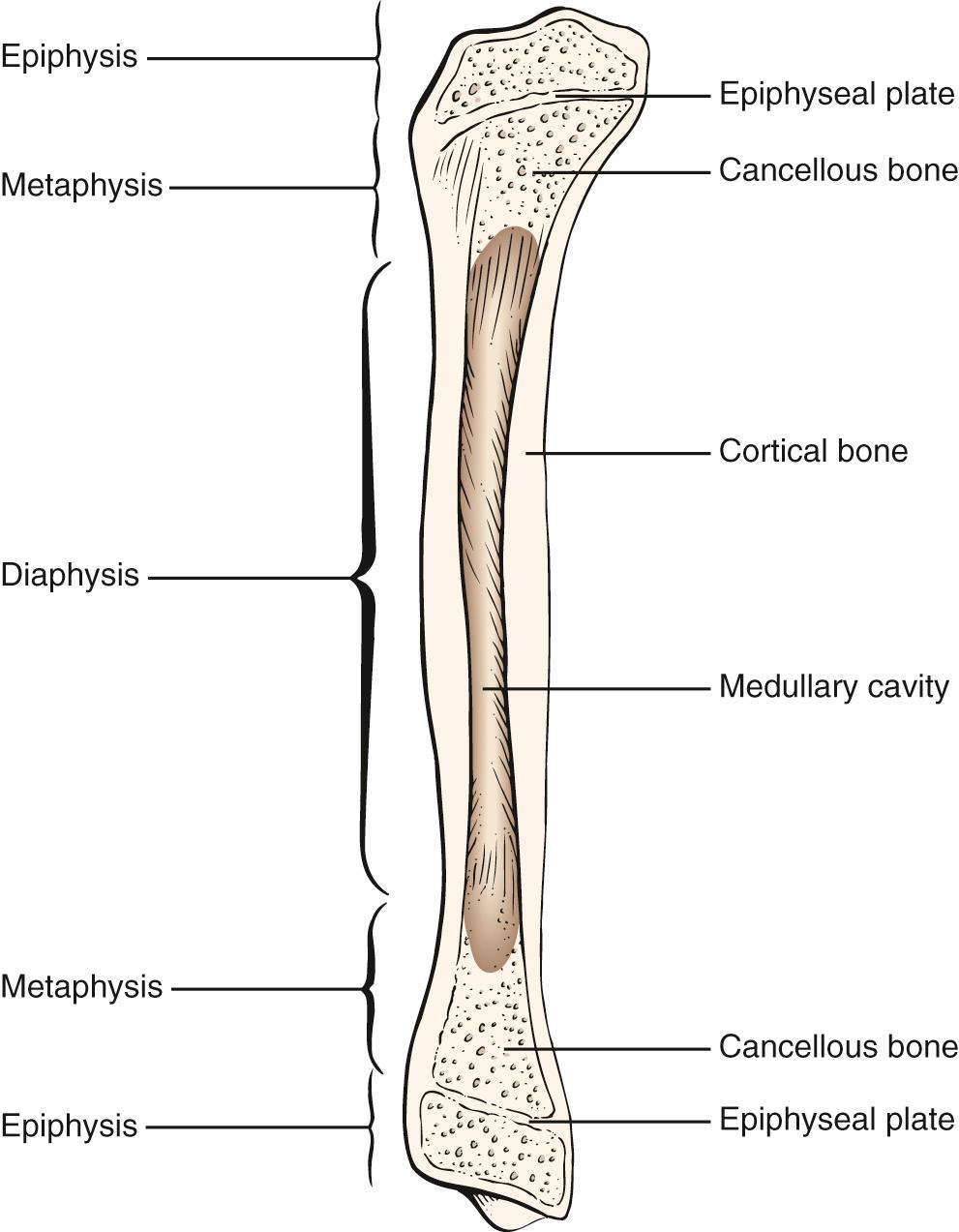
Cells in the periosteum can develop into osteoblasts, which lay down new bone, or into osteoclasts, which resorb bone. Trauma, infection, and tumors stimulate the development of osteoblasts. Osteoblasts secrete the matrix that is refashioned into lamellae and arranged to endure the mechanical stresses to which the bone is subjected. Paget disease is a disease with pathologic process that interferes and disrupts the normal bone architecture. Patients with this condition are extremely susceptible to pathologic fractures.
Skeletal muscle is an organ, the contraction of which produces movement.
Ligaments attach bone to bone, and tendons attach muscle to bone. Both are dense connective tissues that offer great resistance to pulling forces. Ligaments appear as crisscross bands that help stabilize a joint. The anterior cruciate ligament (ACL) attaching the femur to the tibia is an example. Tendons are located at the end of a muscle and attach the muscle to a bone. The Achilles tendon attaches the gastrocnemius and soleus muscles to the calcaneus.
Cartilage is a type of connective tissue with great resilience. It plays an important role in joint function and in determining bone length. Cartilage allows our bones to move easily, to glide over each other with very little friction. Unlike other types of tissue, cartilage does not have a blood supply. Because of this, damaged cartilage takes much longer to heal, compared with other tissues that are supplied by blood.
The basic functional unit of the musculoskeletal system is the joint. A joint is comprised of two or more bones. There are several types of joints in the body:
Immovable
Slightly movable
Movable
Immovable joints are fixed as a result of fibrous tissue banding. Examples of this type of joint are the sutures of the skull and the sacroiliac joints. Slightly movable joints are termed symphyses. In this type of joint, fibrocartilage joins the articulating bones. The pubic symphysis is an example of a slightly movable joint. The most common type of joint is the movable joint. The body has many different types of movable joints, also known as synovial joints. In synovial joints, the bone structures come in contact with each other and are covered with hyaline articular cartilage. A capsule surrounds the joint by attaching to the bones on either side of the joint. Within the capsule is a small amount of synovial fluid, which provides lubrication and nourishment of the articular cartilage. Synovial joints are classified according to the type of movement their structure permits. The classifications are as follows:
Hinge joint
Pivot joint
Condyloid joint
Saddle joint
Ball-and-socket joint
Plane joint
A hinge joint permits movement in only one axis, namely flexion or extension. The axis is transverse. An example of a hinge joint is the elbow. A pivot joint permits rotation in one axis. The axis is longitudinal along the shaft of the bone. One bone moves around a central axis without any displacement from that axis. An example of a pivot joint is the proximal radioulnar joint. A condyloid joint permits movement in two axes. The articular surfaces are oval; thus these joints have been described as “egg-in-spoon” joints. One axis is the long diameter of the oval, and the other axis is the short diameter of the oval. The wrist joint is an example of a condyloid joint. A saddle joint is also a biaxial joint. The articular surfaces are saddle-shaped, with movements similar to those of a condyloid joint. The carpometacarpal joint of the thumb is an example of a saddle joint. The ball-and-socket joint is an example of a polyaxial joint; motion is possible in many axes. In a ball-and-socket joint, the articular surfaces are reciprocal segments of a sphere. The hip and shoulder joints are examples of ball-and-socket joints. A plane joint is also a polyaxial joint. In the plane joint, the articular surfaces are flat, and one bone merely rides over the other in many directions. The patellofemoral joint is an example of a plane joint. The different types of movable joints are shown in Fig. 20.2 .
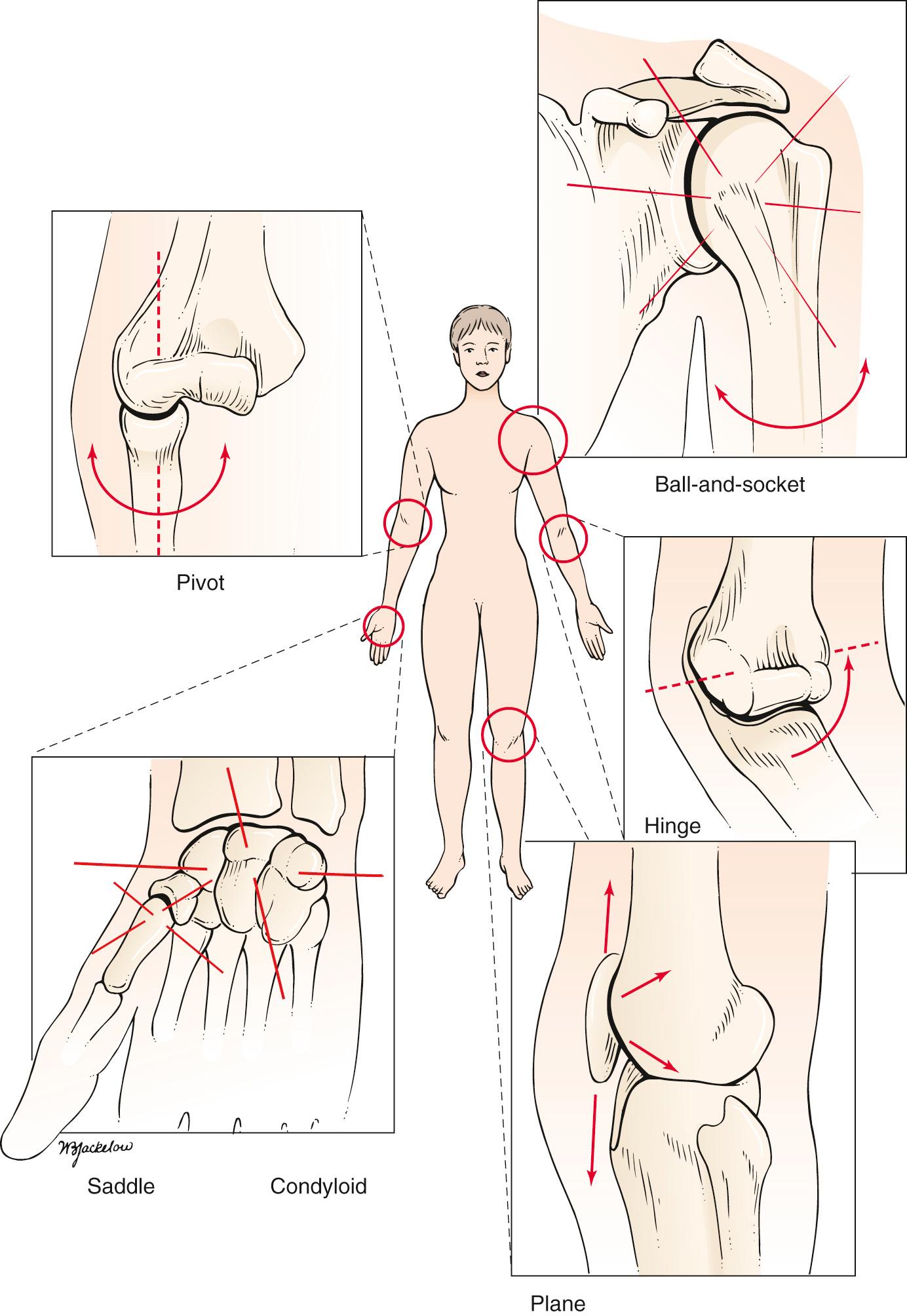
The stability of a joint depends on the following:
Shape of the articular surfaces
Ligaments
Associated muscles
It is necessary to be familiar with certain anatomic terms that refer to position ( Table 20.3 ). The median plane bisects the body into right and left halves. A plane parallel to the median plane is a sagittal plane. The terms medial and lateral are used in reference to the sagittal plane. A position closer to the median plane is medial; farther from the median plane, it is lateral. In the upper limb, the term ulnar is often used to denote medial, and radial to denote lateral. In the lower limb, tibial is used to denote medial, and peroneal or fibular denotes lateral. These anatomic terms are illustrated in Fig. 20.3 .
| Limb | Medial | Lateral |
|---|---|---|
| Upper | Ulnar | Radial |
| Lower | Tibial | Peroneal fibular |
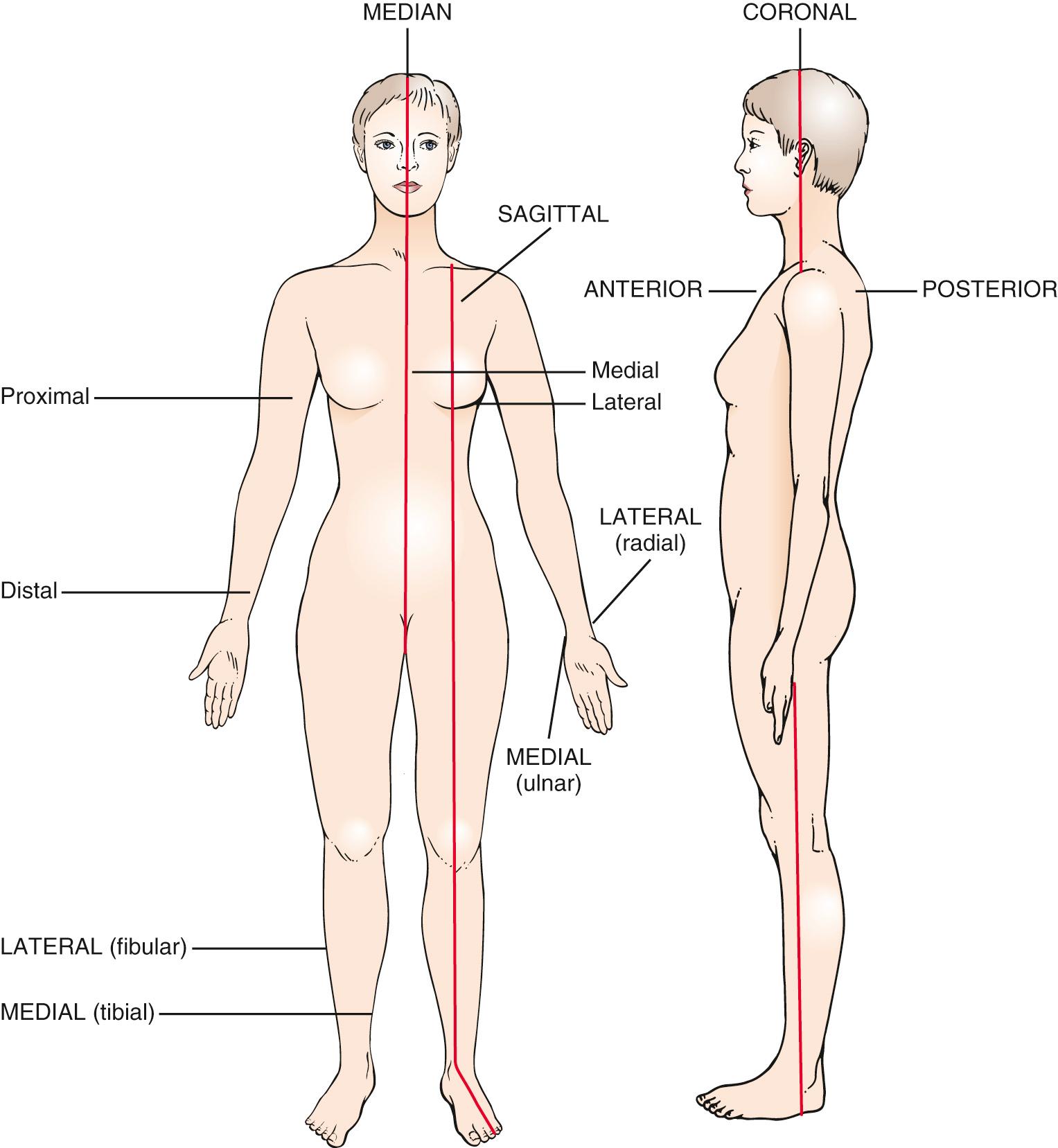
The front of the body is the anterior, or ventral, surface, and the back of the body is the posterior, or dorsal, side. The palmar, or volar, aspect of the hand is the anterior surface. The dorsal aspect of the foot faces upward, and the plantar aspect is the sole. Proximal refers to the part of an extremity that is closest to its root; distal refers to the part farthest from the root.
The most important terms relating to deformities of the bone structure are valgus and varus. In a valgus deformity, the distal portion of the bone is displaced away from the midline, and angulation is toward the midline. In a varus deformity, the distal portion of the extremity is displaced toward the midline, and angulation is away from the midline. The name of the deformity is determined by the joint involved. A valgus deformity of the knees, knock-knee, is termed genu valgum. A varus deformity of the knee, bowleg, is termed genu varum.
In the evaluation of a joint, assess the range of motion. Each joint has a characteristic range of motion that can be measured passively and actively. Passive range of motion is the motion elicited when the examiner moves the patient's body. Active range of motion is the motion the patient performs as a result of moving the musculature. The passive range of motion usually equals the active range of motion except in cases of paralyzed muscles or ruptured tendons. The range of motion of individual joints is discussed later in this chapter. Joint motion is measured in degrees of a circle, with the joint at the center. If a limb is extended with the bones in a straight line, the joint is at zero position. The zero position is the neutral position of the joint. As the joint is flexed, the angle increases. The concept of range of motion is illustrated in Fig. 20.4 .
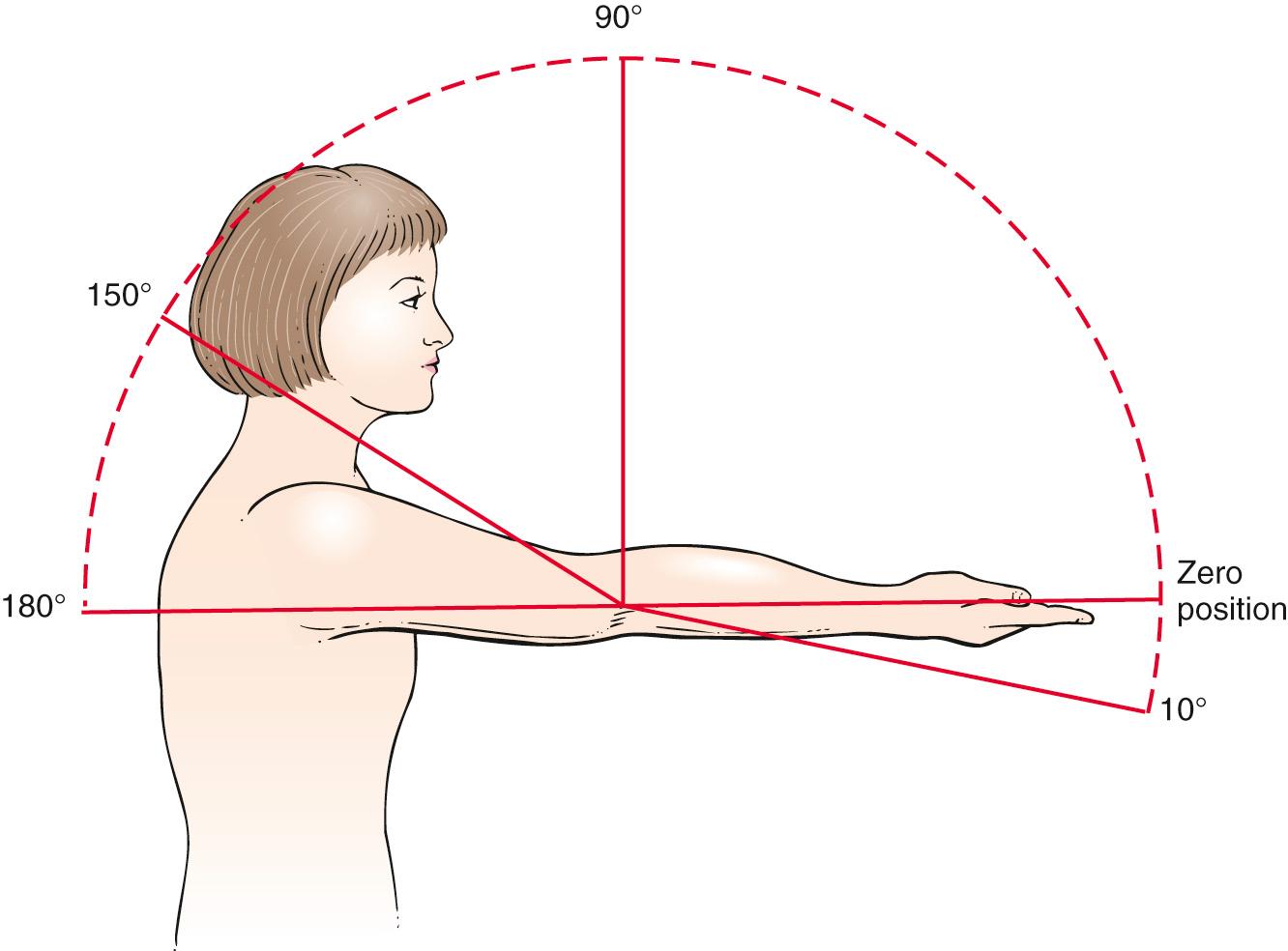
The six basic types of joint motion are as follows:
Flexion and extension
Dorsiflexion and plantar flexion
Adduction and abduction
Inversion and eversion
Internal and external rotation
Pronation and supination
The definitions of these motions and the joints at which they occur are summarized in Table 20.4 .
| Motion | Definition | Example |
|---|---|---|
| Flexion | Motion away from the zero position | Most joints |
| Extension | Return motion to the position a | Most joints |
| Dorsiflexion | Movement in the direction of the dorsal surface | Ankle, toes, wrist, fingers |
| Plantar (or palmar) flexion | Movement in the direction of the plantar (or palmar) surface | Ankle, toes, wrist, fingers |
| Adduction | Movement toward the midline b | Shoulder, hip, metacarpophalangeal, metatarsophalangeal joints |
| Abduction | Movement away from the midline | Shoulder, hip, metacarpophalangeal, metatarsophalangeal joints |
| Inversion | Turning of the plantar surface of the foot inward | Subtalar and midtarsal joints of the foot |
| Eversion | Turning of the plantar surface of the foot outward | Subtalar and midtarsal joints of the foot |
| Internal rotation | Turning of the anterior surface of a limb inward | Shoulder, hip |
| External rotation | Turning of the anterior surface of a limb outward | Shoulder, hip |
| Pronation | Rotation so that the palmar surface of the hand is directed downward | Elbow, wrist |
| Supination | Rotation so that the palmar surface of the hand is directed upward | Elbow, wrist |
a Extension that goes beyond the zero position is called hyperextension.
b In the hand or foot, the midline is an imaginary line through the middle finger or middle toe, respectively.
The anatomy of the shoulder joint is illustrated in Fig. 20.5 . The joint movements at the shoulder are abduction and adduction, flexion and extension, and internal and external rotation. These motions are illustrated in Fig. 20.6 .
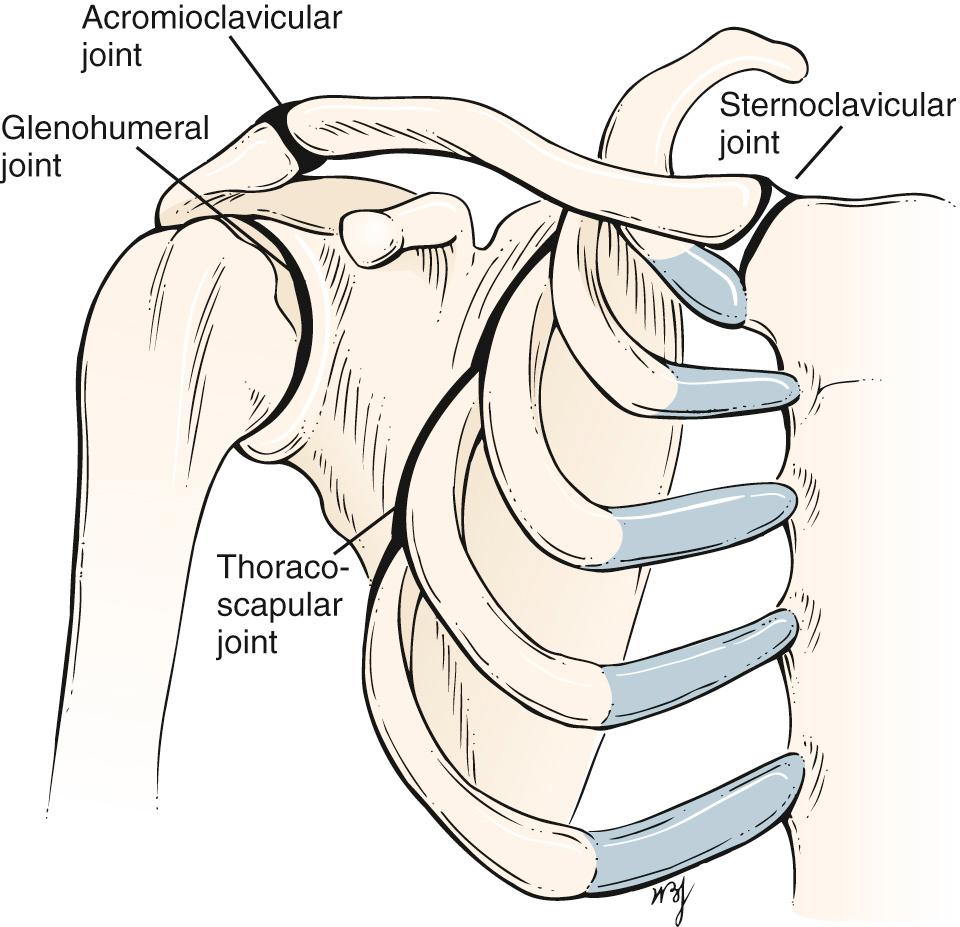
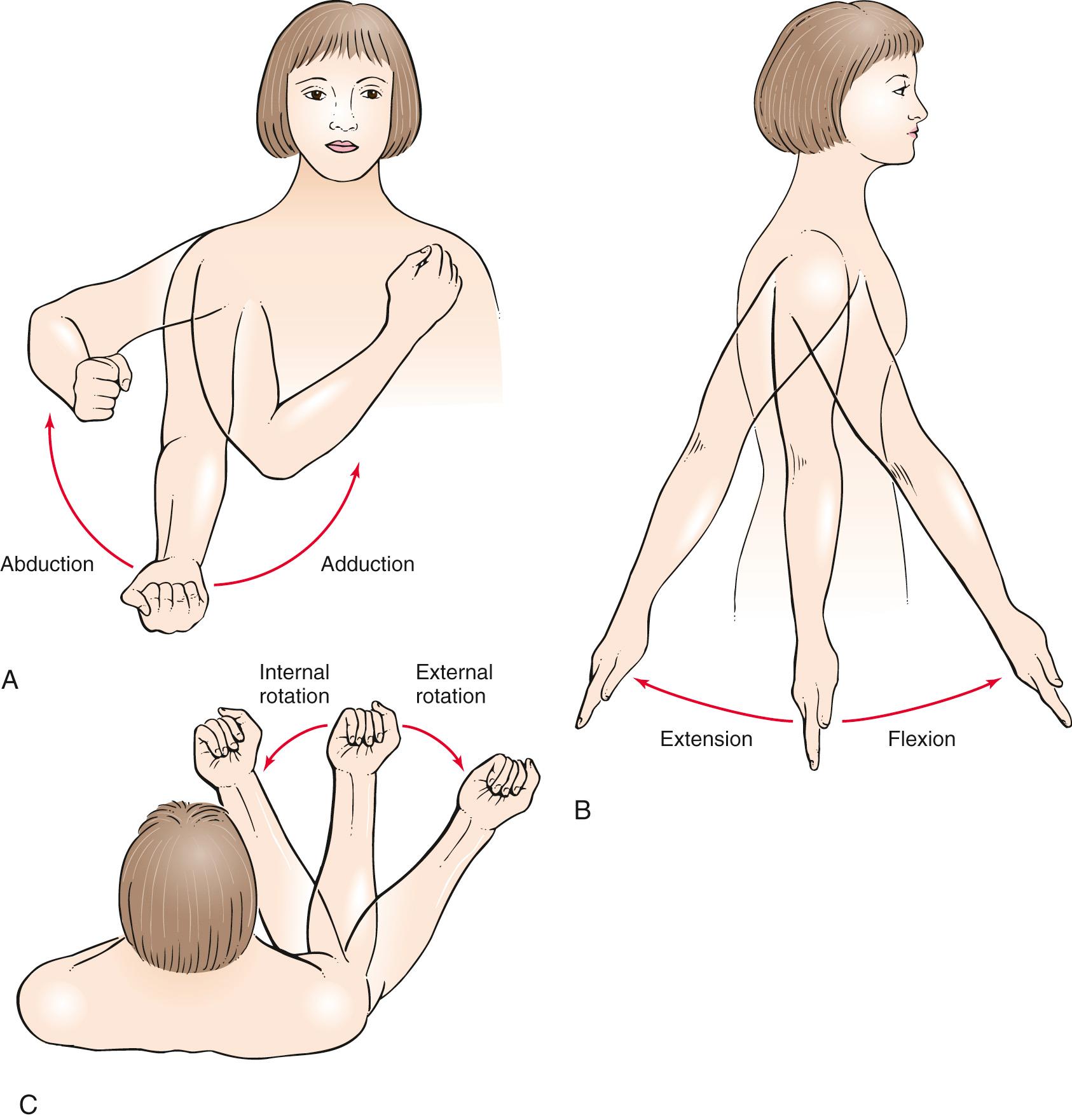
The anatomy of the elbow joint is shown in Fig. 20.7 . The joint movements at the elbow are flexion and extension, and supination and pronation. These motions are illustrated in Fig. 20.8 .
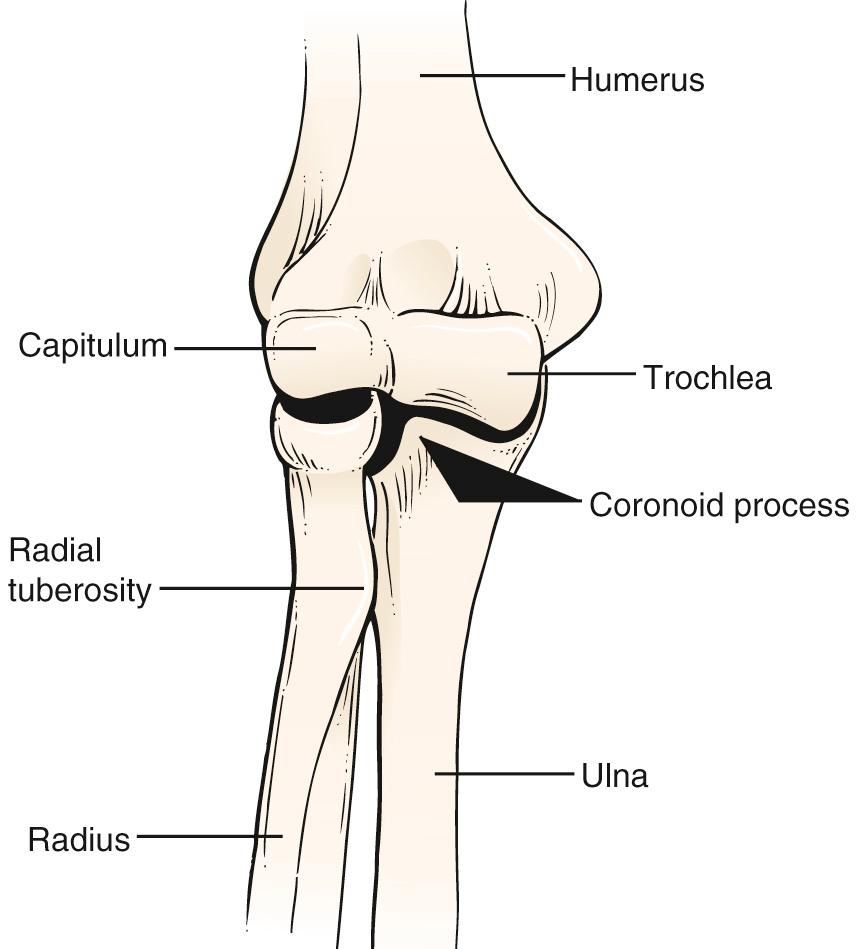
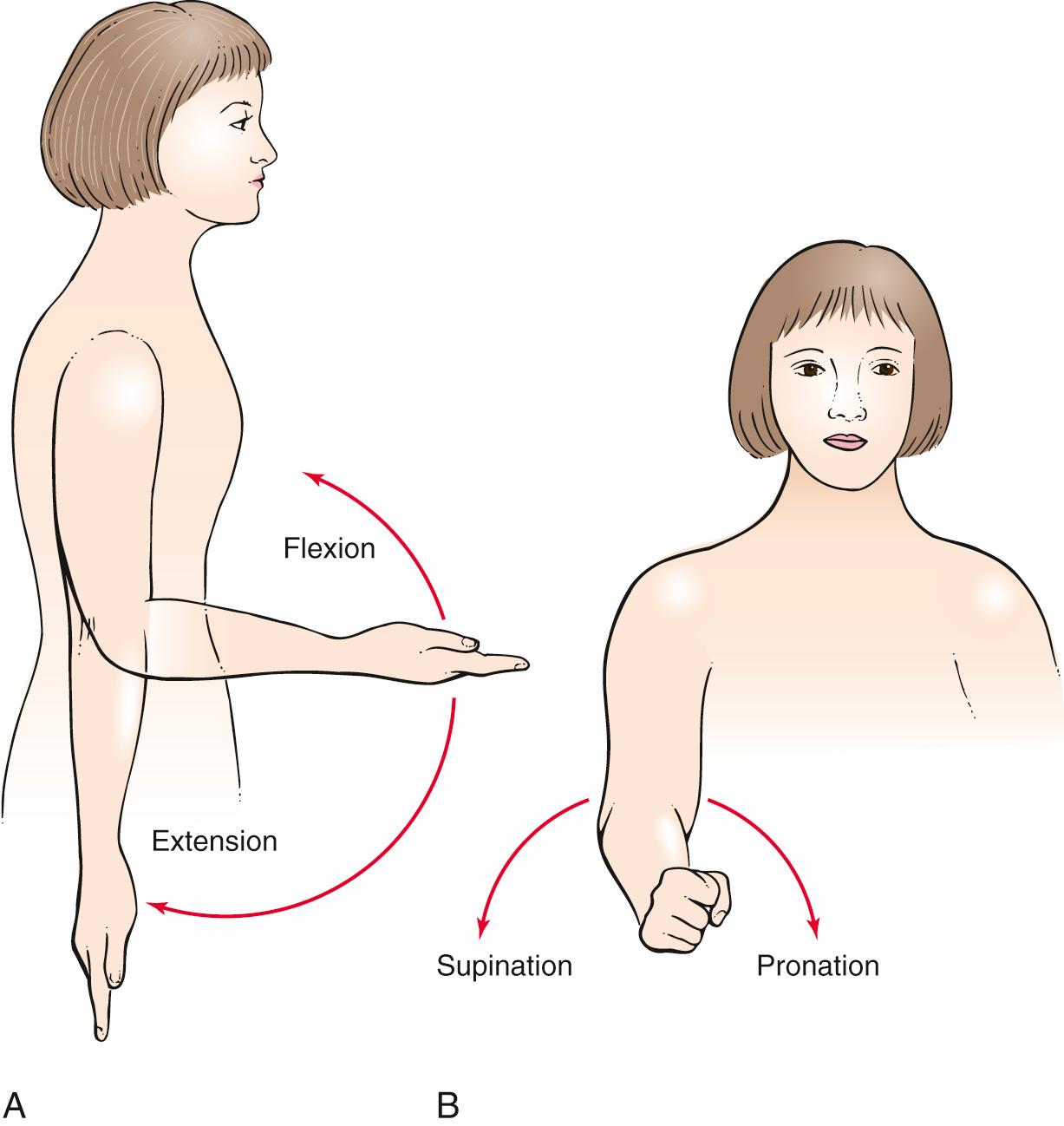
The anatomy of the wrist and fingers is illustrated in Fig. 20.9 . The joint movements at the wrist are dorsiflexion (or extension) and palmar flexion and supination and pronation. These motions are illustrated in Fig. 20.10 . The joint movements at the fingers are abduction and adduction, and flexion and extension. These motions are illustrated in Fig. 20.11 . The joint movements of the thumb are flexion and extension, abduction and adduction, and opposition. These motions are illustrated in Fig. 20.12 .
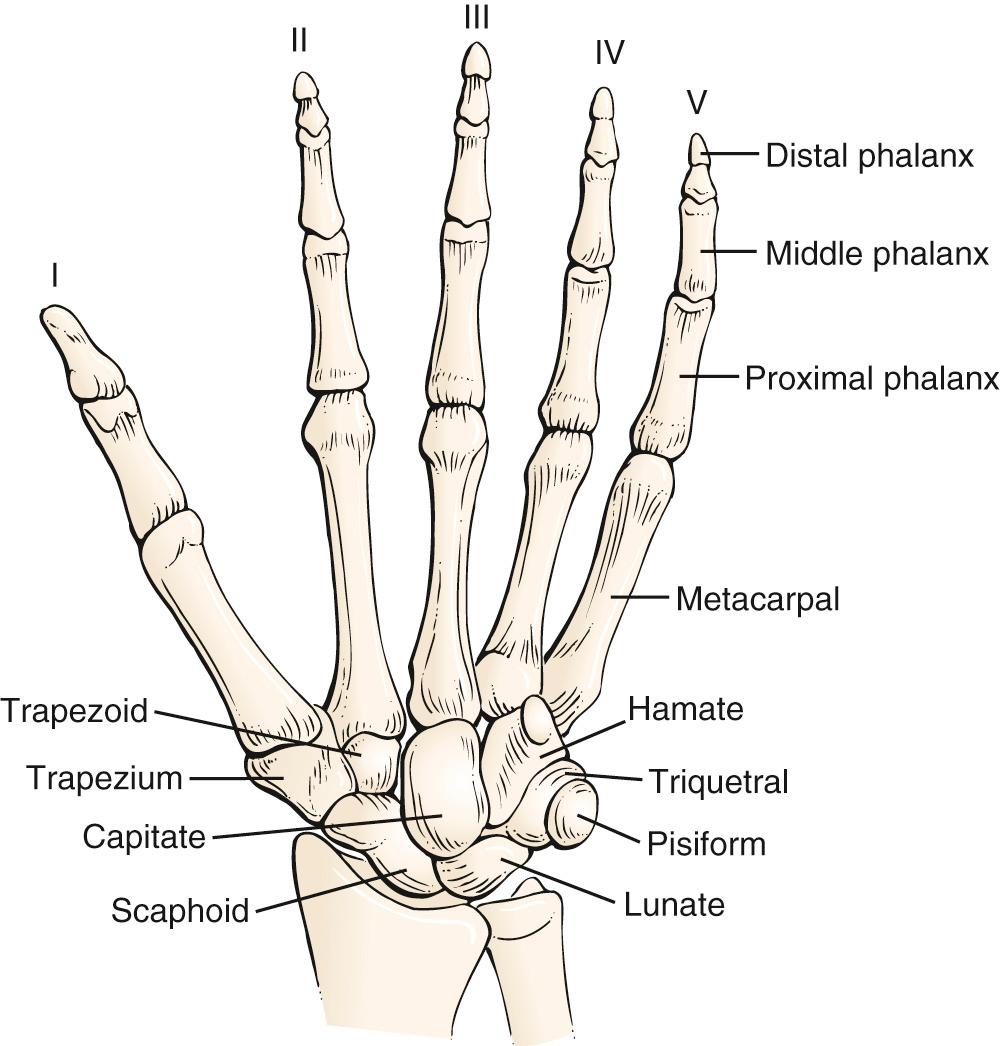
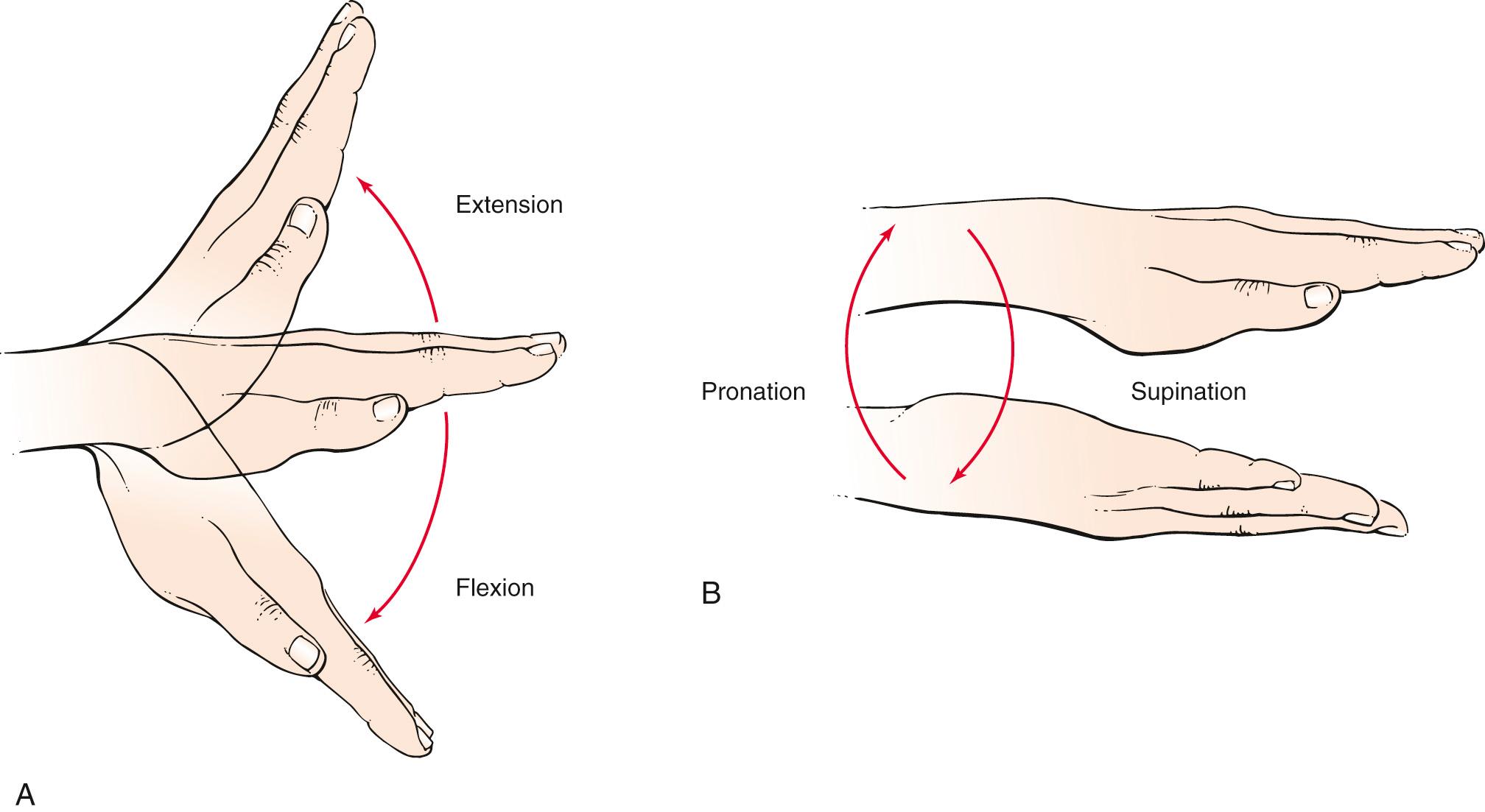
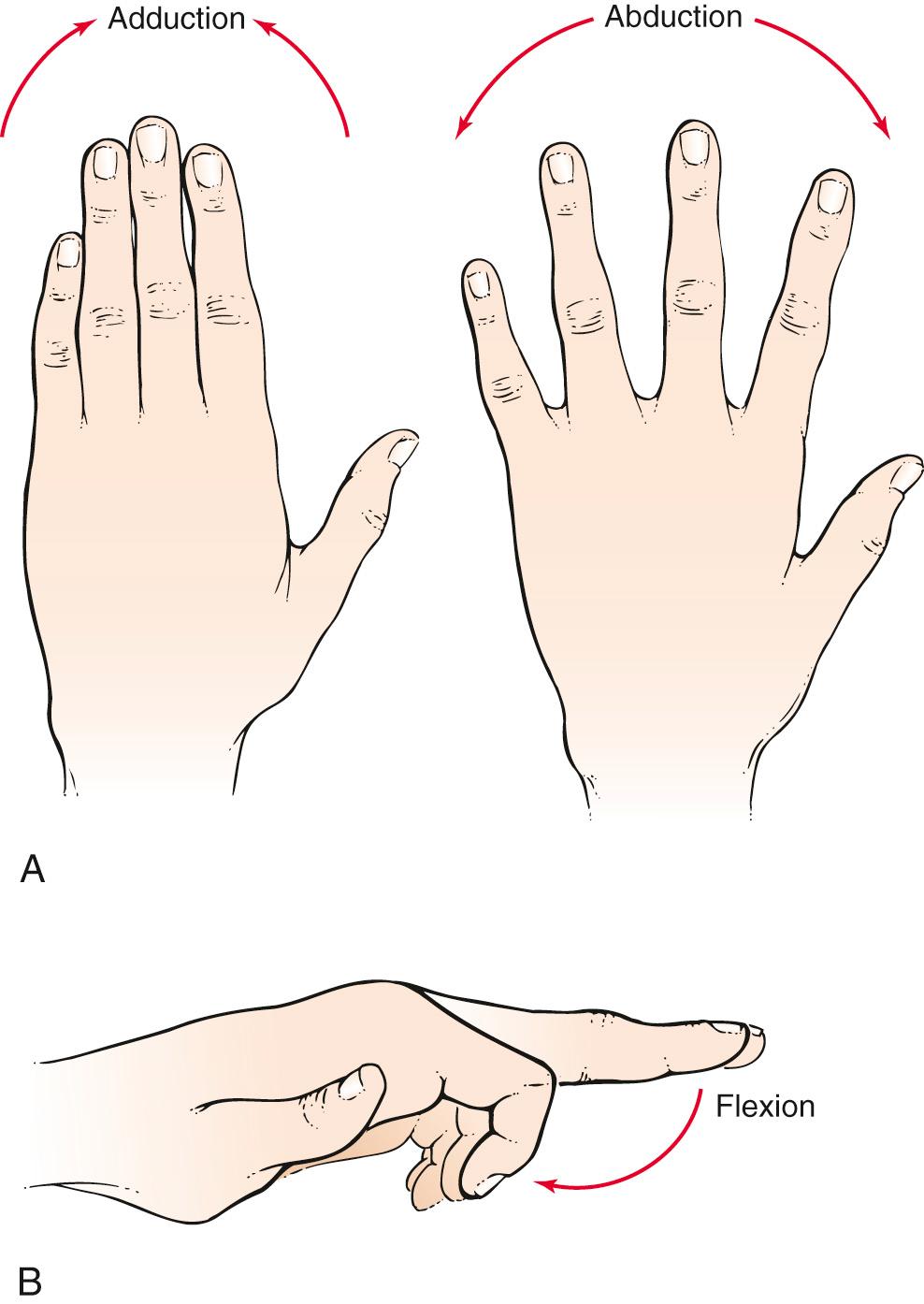
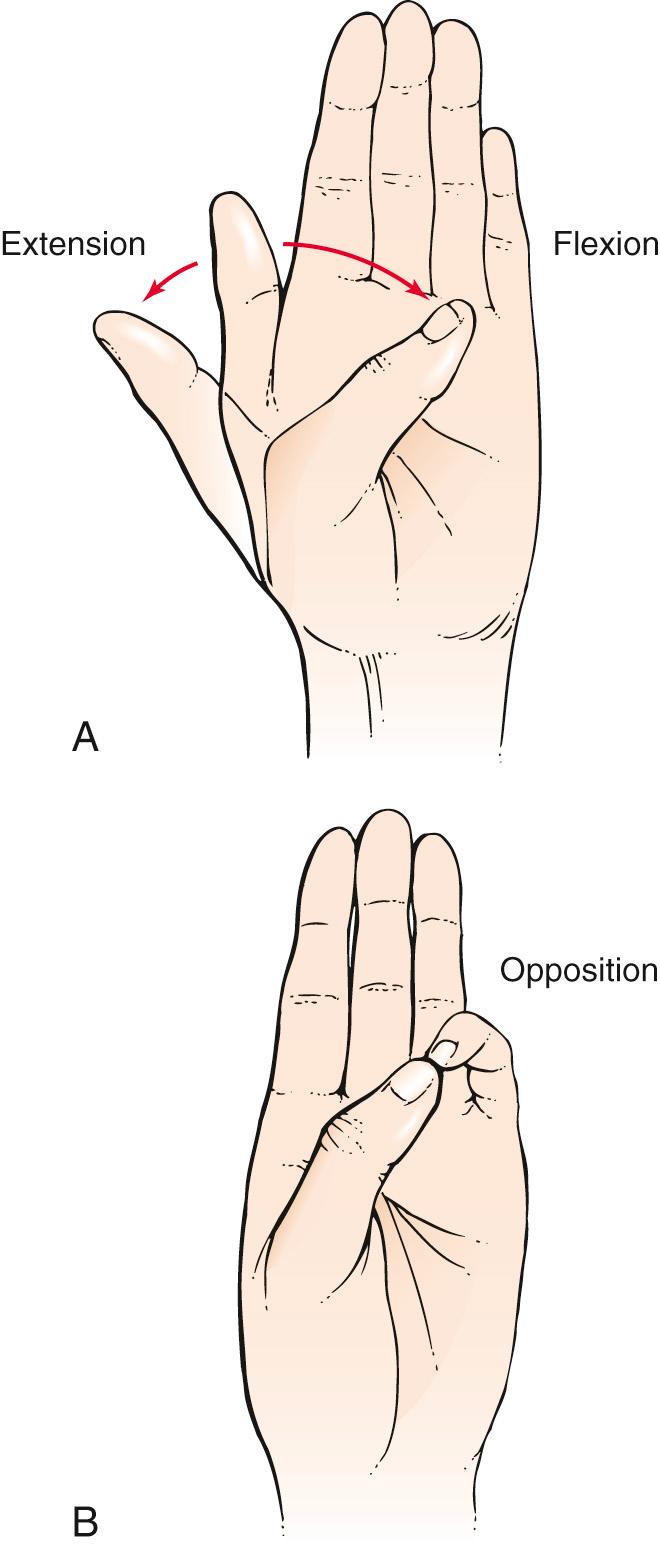
The anatomy of the hip is illustrated in Fig. 20.13 . The joint movements at the hip are flexion and extension, abduction and adduction, and internal and external rotation. These motions are illustrated in Fig. 20.14 .
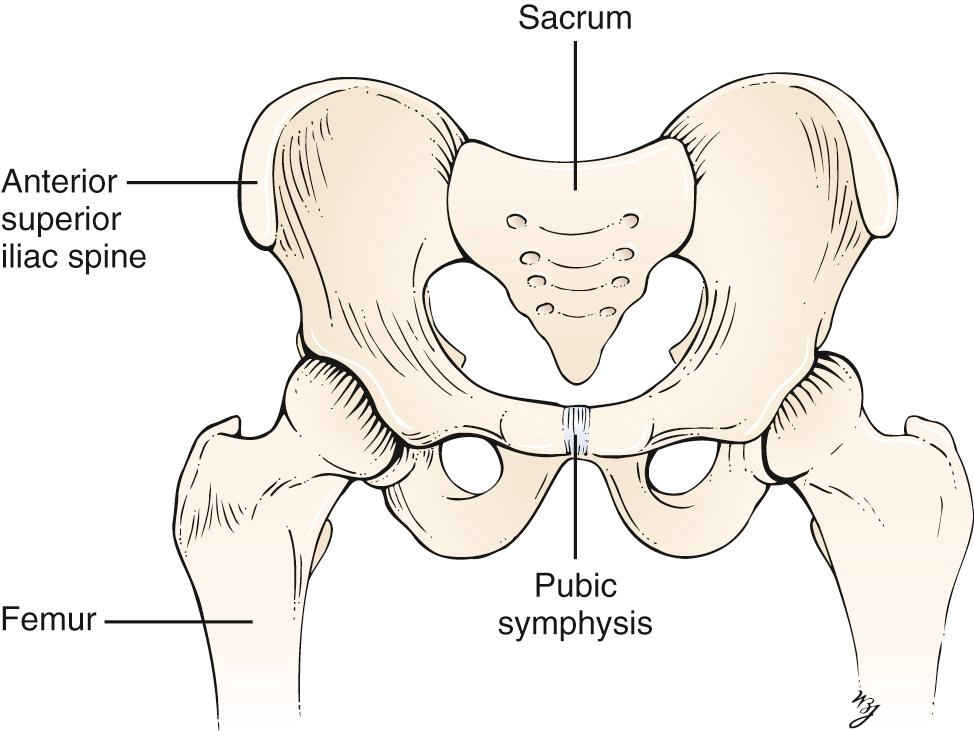
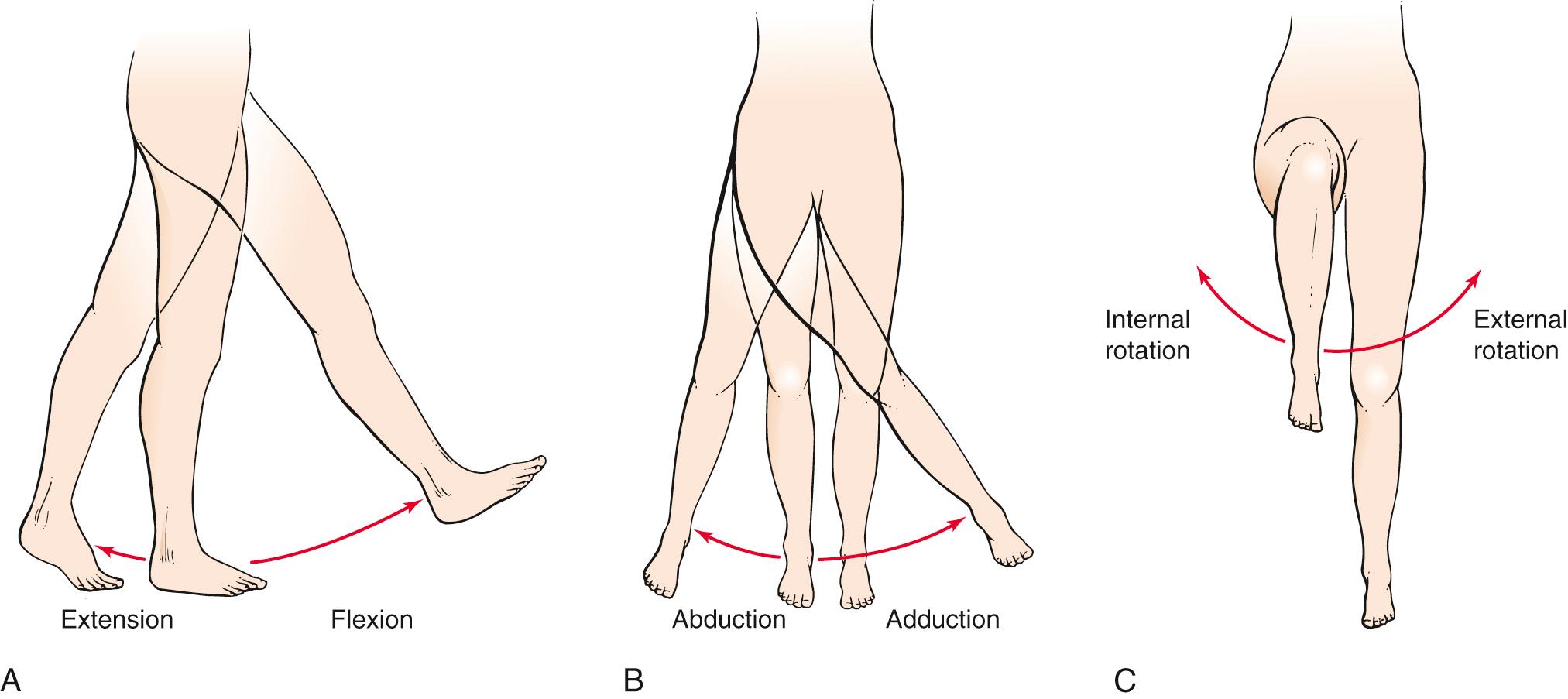
The anatomy of the knee is shown in Fig. 20.15 . The joint movements at the knee are flexion and extension. These motions are illustrated in Fig. 20.16 .
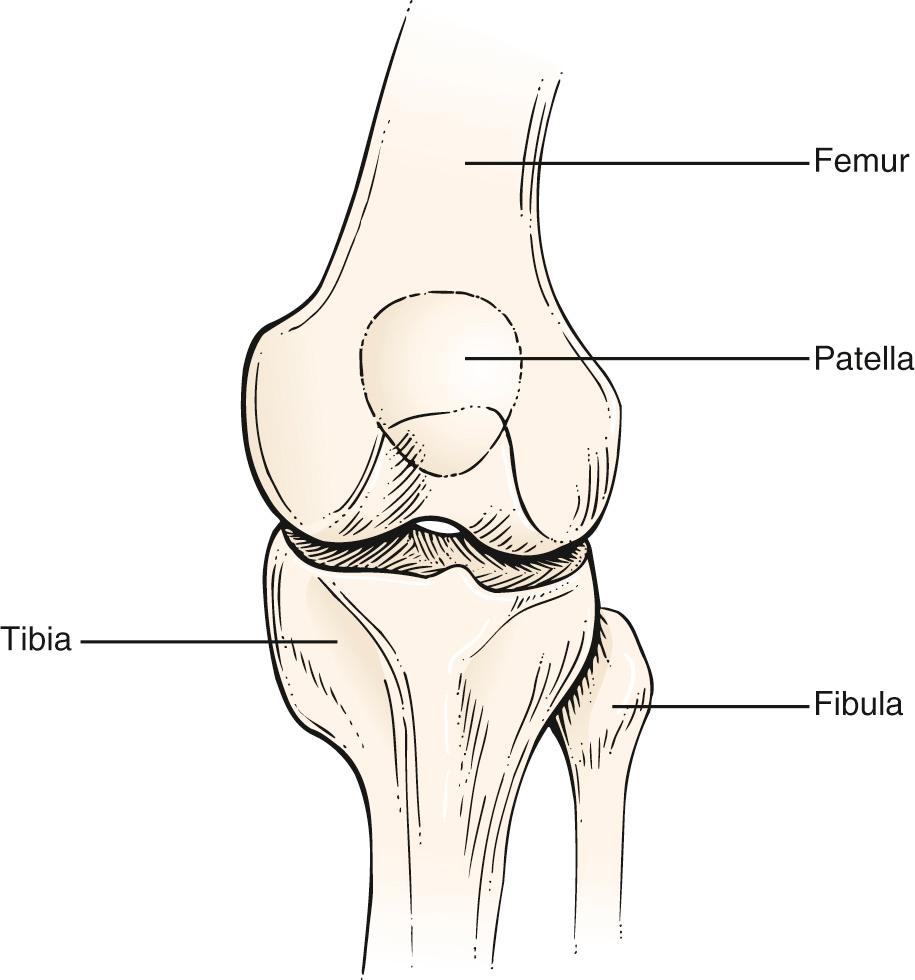
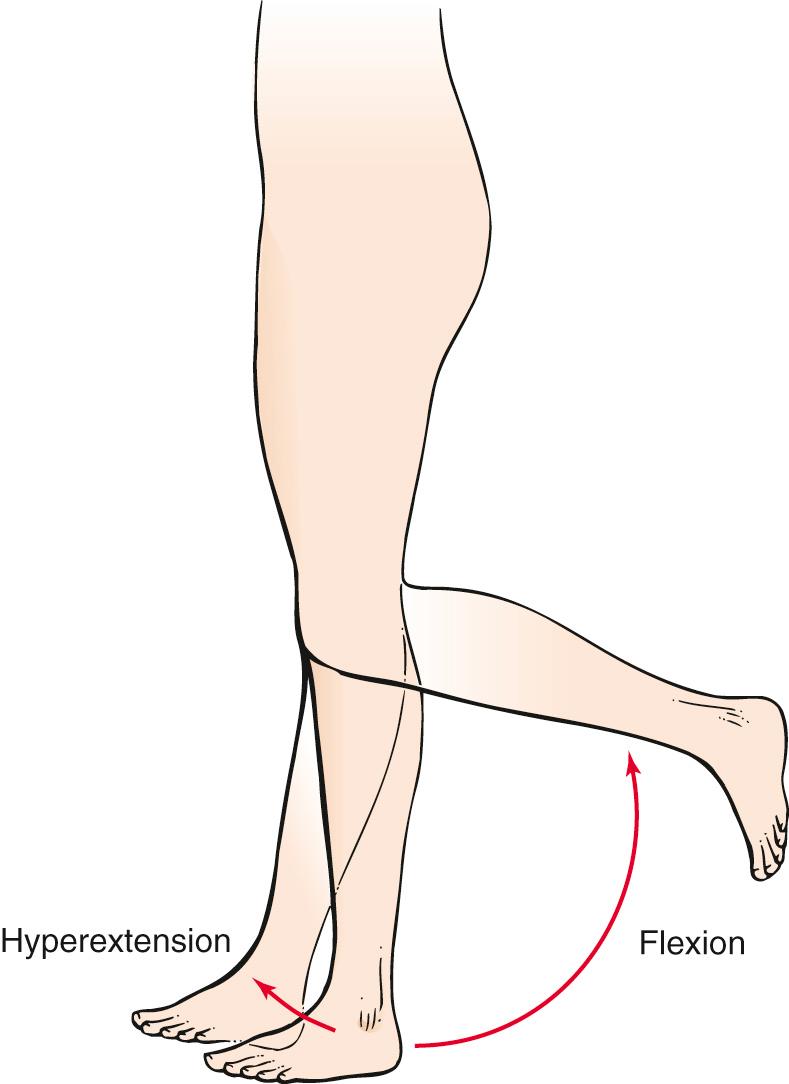
The anatomy of the ankle and foot is illustrated in Fig. 20.17 . There are 26 bones and 55 articulations in the foot. The bones can be divided into three regions: forefoot, midfoot, and hind foot. The forefoot is represented by the 14 bones of the toes and 5 metatarsals. The big toe (hallux) has two phalanges and one joint (interphalangeal [IP] joint) and two tiny and round sesamoid bones that enable it to move up and down. The sesamoid bones are about the size of a kernel of corn. These bones are embedded in the flexor hallucis brevis tendon, one of several tendons that exert pressure from the big toe against the ground and help initiate the act of walking: the propulsive phase of the gait cycle. The other four toes each have three bones and two joints. The phalanges are connected to the metatarsals by five metatarsophalangeal (MTP) joints at the ball of the foot. The forefoot bears half the body's weight and balances pressure on the ball of the foot.
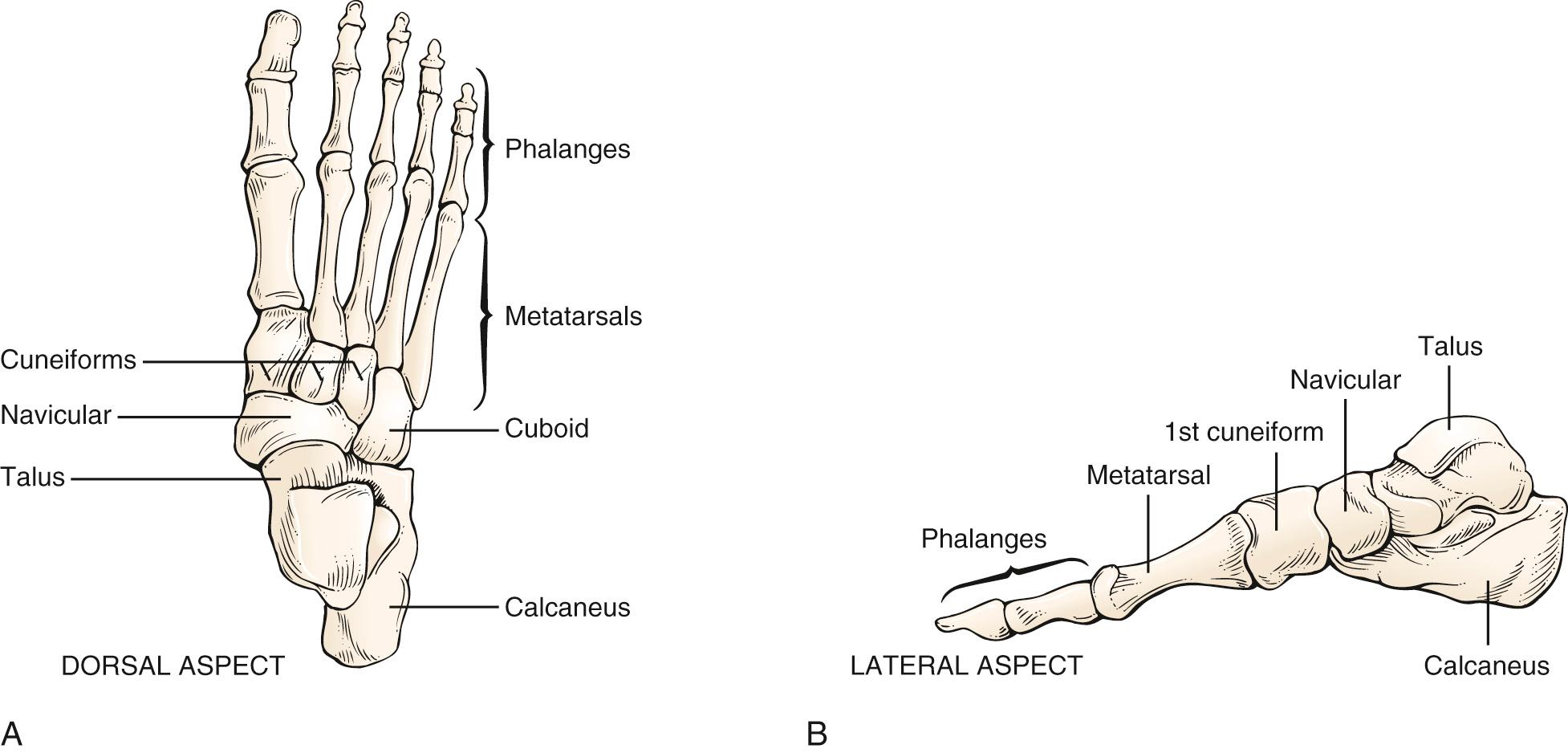
The midfoot consists of the three cuneiform bones, the cuboid, and the navicular. The midfoot has five irregularly shaped tarsal bones, forms the foot's arch, and serves as a shock absorber. The bones of the midfoot are connected to the forefoot and the hindfoot by muscles and the plantar fascia (arch ligament).
The hind foot is composed of the talus and the calcaneus. The foot contains two arches: the longitudinal in the midpart and the transverse in the forepart. The midtarsal joint is formed by the articulations of the navicular to the talus and the calcaneus to the cuboid. The largest tarsal bone is the calcaneus, the bottom of which is cushioned by a layer of fat. The attachment of the foot to the leg occurs through the talus. The joint movements at the ankle are dorsiflexion and plantar flexion. The motion of the subtalar joint is inversion and eversion. These motions are illustrated in Fig. 20.18 .
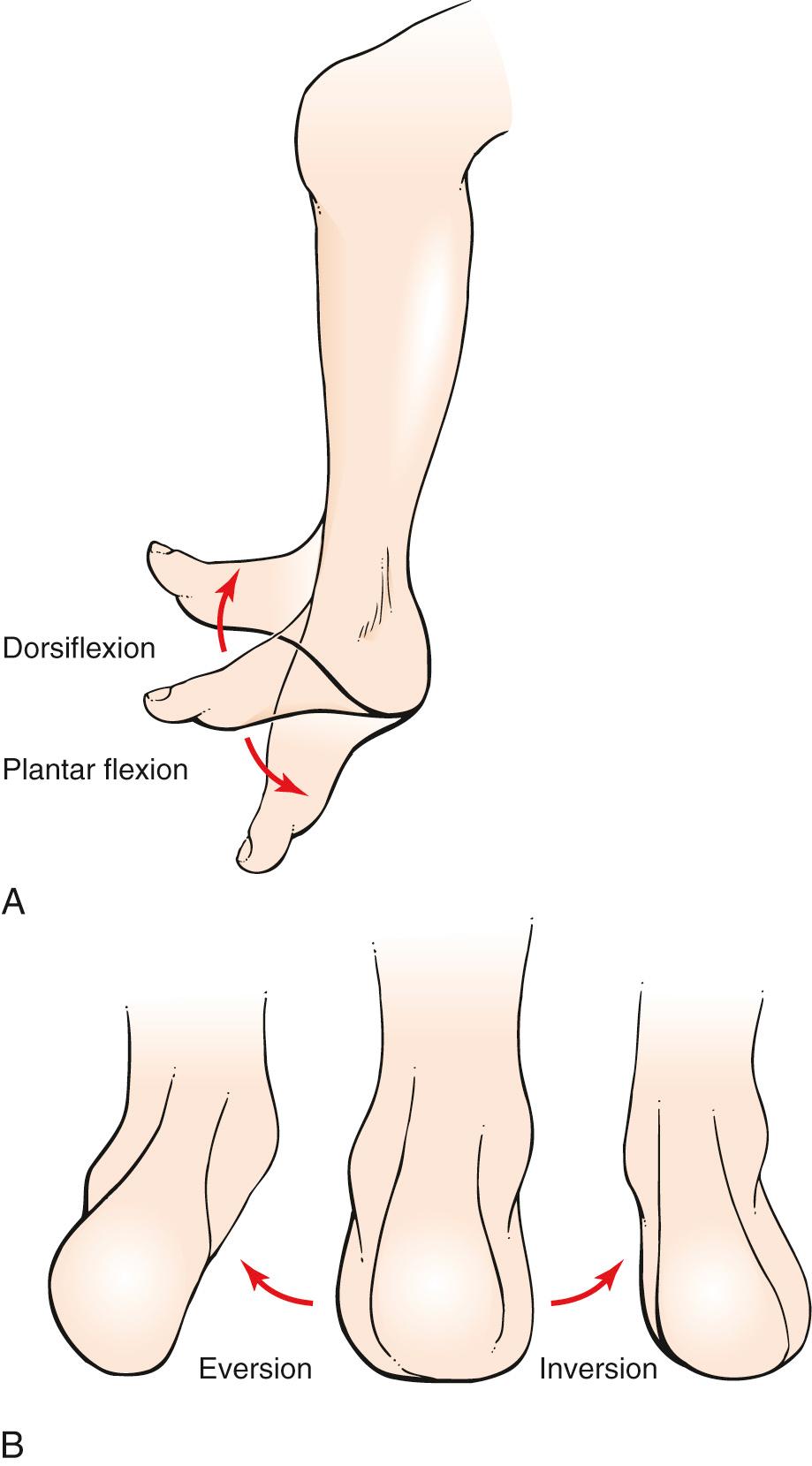
The anatomy of the cervical spine is shown in Fig. 20.19 . The joint movements of the neck are flexion and extension, rotation, and lateral flexion. These motions are illustrated in Fig. 20.20 .
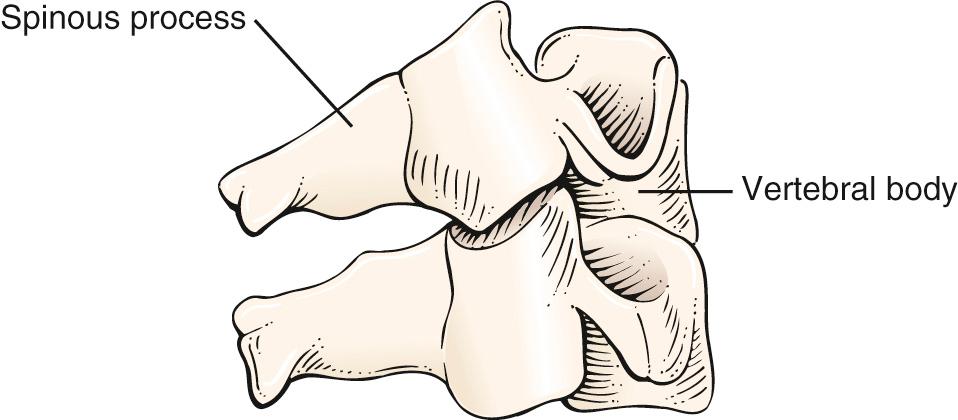
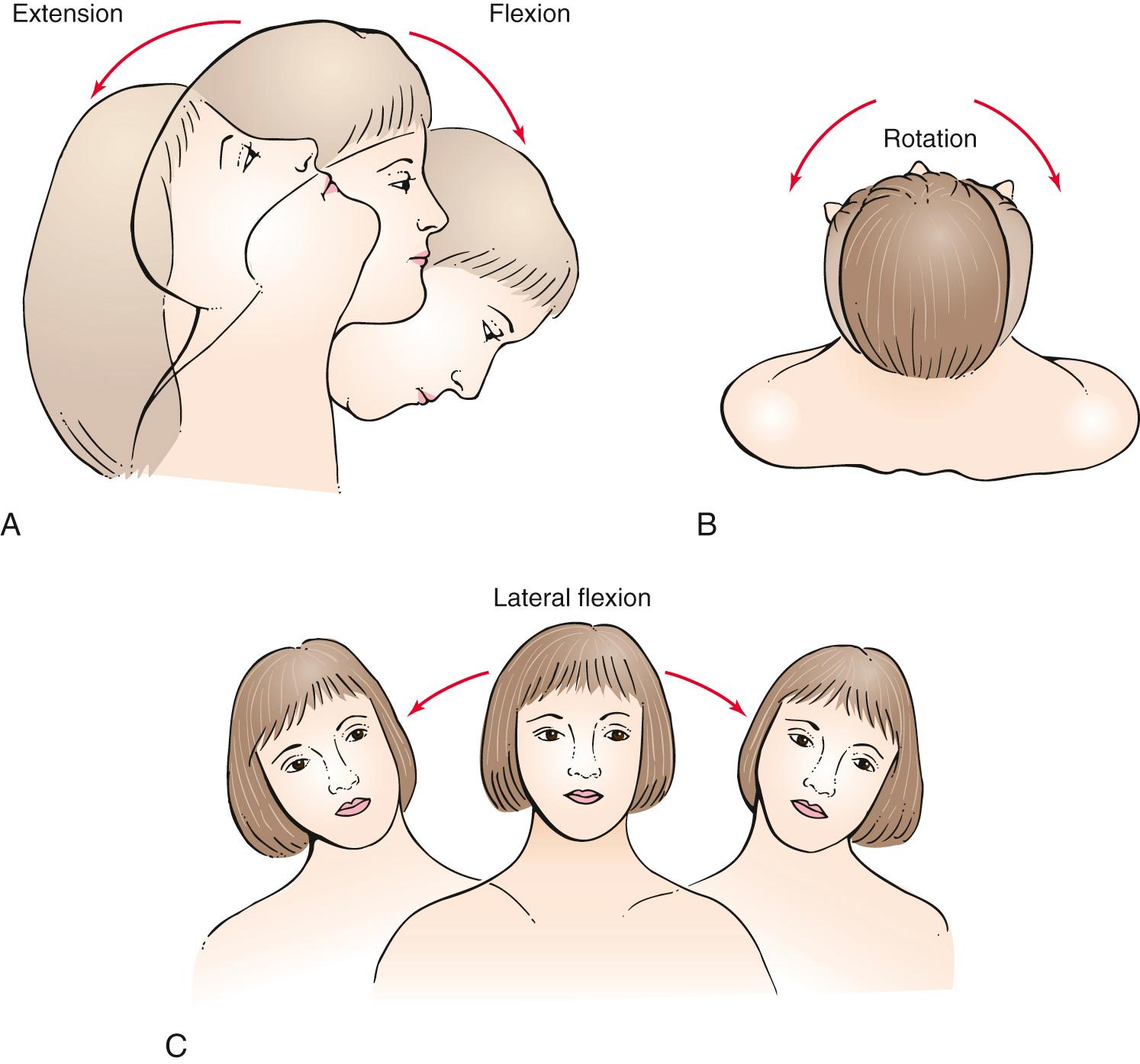
The anatomy of the lumbar spine is illustrated in Fig. 20.21 . The joint movements of the lumbar spine are flexion and extension, rotation, and lateral extension. These motions are illustrated in Fig. 20.22 .
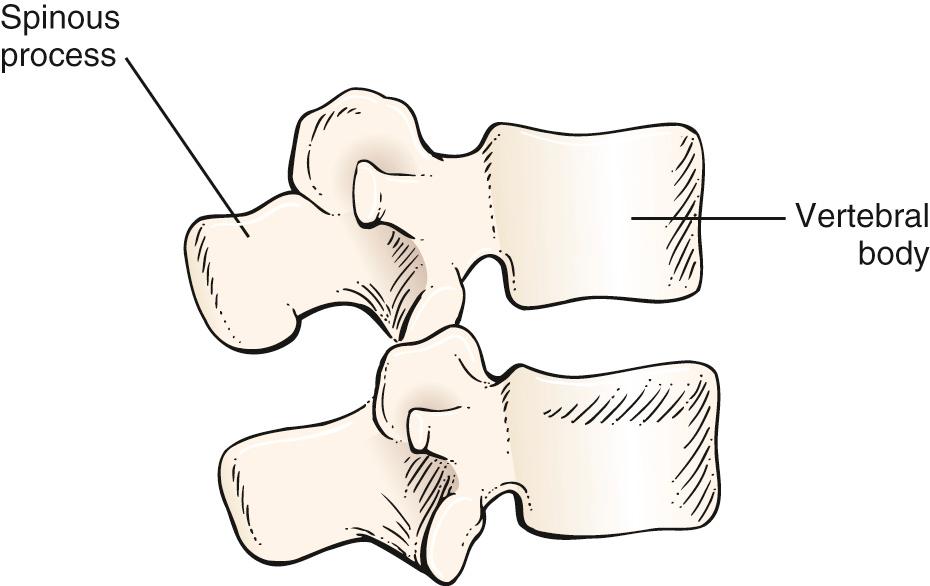
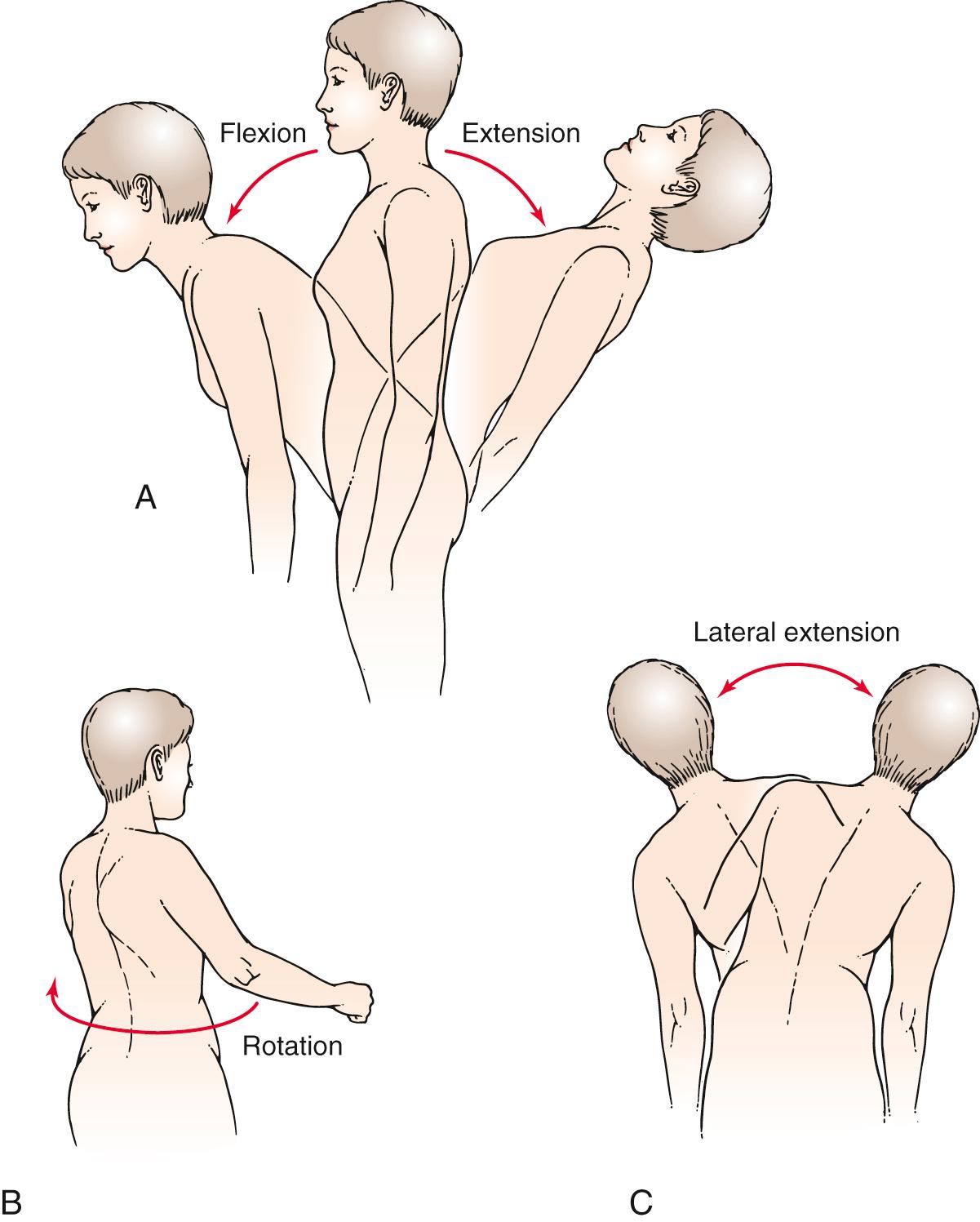
A summary of normal joint ranges of motion is shown in Table 20.5 .
| Joint | Flexion | Extension | Lateral Bending | Rotation |
|---|---|---|---|---|
| Cervical spine | 45 degrees | 55 degrees | 40 degrees | 70 degrees |
| Thoracic and lumbar spine | 75 degrees | 30 degrees | 35 degrees | 30 degrees |
| Shoulder | 180 degrees | 50 degrees | Abduction; 180 degrees | Adduction; 50 degrees |
| Elbow | 150 degrees | 180 degrees | Pronation; 80 degrees | Supination; 80 degrees |
| Wrist | 80 degrees | 70 degrees | Radial motion; 20 degrees | Ulnar motion; 55 degrees |
| Metacarpophalangeal joint | 90 degrees | 20 degrees | — | — |
| Hip | 90 degrees with knee extended | 30 degrees with knee extended | 40 degrees | 45 degrees |
| 120 degrees with knee flexed | — | Abduction; 45 degrees | Adduction; 30 degrees | |
| Knee | 135 degrees | 0–10 degrees | — | — |
| Ankle | 50 degrees | 15 degrees | — | — |
| Subtalar | — | — | Inversion; 20 degrees | Eversion; 10 degrees |
| First metatarsophalangeal joint | 40 degrees | 65–75 degrees | — | — |
The most common symptoms of musculoskeletal disease are as follows:
Pain
Weakness
Deformity
Limitation of motion
Stiffness
Swelling
Joint clicking
The location, character, and onset of each of these symptoms must be ascertained. It is important for the interviewer to determine the time course of any of these symptoms.
Pain can result from disorders of the bone, muscle, or joint. Ask the following questions:
“When did you first become aware of the pain?”
“Where do you feel the pain? Point to the most painful spot with one finger.”
“Did the pain occur suddenly?”
“Does the pain occur daily?”
“During which part of the 24-hour day is your pain worse: Morning? Afternoon? Evening?”
“Did a recent illness precede the pain?”
“What makes the pain worse?”
“What do you do to relieve the pain?”
“Is the pain relieved by rest?”
“What kinds of medications have you taken to relieve the pain?”
“Have you noticed that the pain changes according to the weather?”
“Do you have any difficulty putting on your shoes or coat?”
“Does the pain ever awaken you from sleep?”
“Does the pain shoot to another part of your body?”
“Have you noticed that the pain moves from one joint to another?”
“Has there been any injury, overuse, or strain?”
“Have you noticed any swelling?”
“Are other bones, muscles, or joints involved?”
“Have you had a recent sore throat?”
Bone pain may occur with or without trauma. It is typically described as “deep,” “dull,” “boring,” or “intense.” The pain may be so intense that the patient is unable to sleep. Typically, bone pain is not related to movement unless a fracture is present. Pain from a fractured bone is often described as “sharp.” Muscle pain is frequently described as “crampy.” It may last only briefly or for longer periods. Muscle pain in the lower extremity on walking (described in Chapter 15 , “The Peripheral Vascular System”) is suggestive of ischemia of the calf or hip muscles. Muscle pain associated with weakness is suspect for a primary muscular disorder. Joint pain is felt around or in the joint. In some conditions, the joint may be exquisitely tender. Movement usually worsens the pain, except with rheumatoid arthritis, in which movement often reduces the pain. Infections need to be ruled out for acute onset pain. However, chronic infection with tuberculosis or fungal infections may smolder for years before pain is present. The severity of the pain can often be assessed by the time interval from pain's onset to the time patient seeks medical attention.
The time of day when the pain is worse may be helpful in diagnosing the disorder. The pain of many rheumatic disorders tends to be accentuated in the morning, particularly on rising. Tendinitis worsens during the early morning hours and eases by midday. OA worsens as the day progresses.
Sudden onset of pain in a MTP joint should raise suspicion of gout. Entrapment syndromes are apt to radiate pain distally. Rheumatoid arthritis and tendinitis often cause early awakening because of pain, particularly when the patient is lying on the affected limb.
Acute rheumatic fever, leukemia, gonococcal arthritis, sarcoidosis, and juvenile rheumatoid arthritis are commonly associated with migratory polyarthritis, in which one joint is affected, the disease subsides, and then another joint becomes involved.
Whether from an accident, sports injury, or general wear-and-tear, knee pain and knee injuries are very common complaints. Meniscal injuries may be the most common knee injury. The menisci are small, rubbery cartilaginous discs, located between the femur and tibia, which act to cushion the knee and allow the bones to glide smoothly against one another. Meniscus tears are common in contact sports such as football as well as noncontact sports requiring jumping and running such as volleyball and soccer. Meniscus tears can be painful and debilitating. Although commonly related to trauma, significant trauma is not necessary. A sudden twist or repeated squatting can tear the meniscus. Pain, swelling, a popping sensation during an injury, difficulty in bending and straightening the leg, and a tendency for the knee to get “stuck” are common symptoms of a meniscal tear. Meniscal tears can often occur with other knee injuries such as ACL injury.
Injuries to the ACL occur typically due to a rotational movement or hyperextension of the knee. They commonly occur in female athletes, but can occur in the most benign, nonsport activities. The ACL is one of the ligaments that stabilize the knee. Athletes who participate in sports that require sudden stopping and quickly changing directions while they are running are prone to ACL injuries. These sports include soccer, football, basketball, tennis, gymnastics, and volleyball. Symptoms are similar to those of a meniscal tear.
Patellofemoral arthritis is an overuse injury, often known as “runner's knee.” It results from softening and deterioration of the cartilage on the posterior aspect of the patella. The condition can also be seen in older adults with arthritis. Manifestations of this form of arthritis range from no symptoms to vague anterior knee pain to severe difficulties with stair climbing and ambulation. Chondromalacia of the patella is used to describe the early manifestations of the articular cartilage that eventually lead to the arthritis.
Viral illnesses are commonly associated with muscle aches and pains. A recent history of a sore throat, with joint pain occurring 10 to 14 days later, is suspect for rheumatic fever. If rest does not relieve the pain, serious musculoskeletal disease may be present. The interviewer should keep in mind the possibility of referred pain. Pain from a hip disorder is frequently referred to the knee, especially in a child.
Muscular weakness should always be differentiated from fatigue. Ascertain which functions the patient is unable to perform as a result of “weakness.” Is the weakness related to proximal or distal muscle groups? Proximal weakness is usually a myopathy; distal weakness is usually a neuropathy. A patient with the symptom of muscular weakness should be asked these questions:
“Do you have difficulty combing your hair?”
“Do you have difficulty lifting objects?”
“Have you noticed any problem with holding a pen or pencil?”
“Do you have difficulty turning doorknobs?”
“Do you have trouble standing up after sitting in a chair?”
“Do you find that, as the day goes on, there is a change in the weakness?” If yes, “Does the weakness worsen or improve?”
“Have you noticed any decrease in your muscle size?”
“Are the weak muscles stiff?”
“Do you have trouble with double vision? Swallowing? Chewing?”
A patient with proximal weakness of the lower extremity has difficulty walking and crossing the knees. A proximal weakness of the upper extremity is manifested by difficulty brushing the hair or lifting objects. Patients with polymyalgia rheumatica have proximal muscle weakness. This condition is discussed in Chapter 25 , The Geriatric Patient. A distal weakness of the upper extremity is manifested by difficulty turning doorknobs or buttoning a shirt or blouse. Patients with myasthenia gravis have generalized weakness, diplopia, and difficulty swallowing and chewing.
Deformity may be the result of a congenital malformation or an acquired condition. In any patient with a deformity, it is important to determine the following:
“When was the deformity first noticed?”
“Did the deformity occur suddenly?”
“Did the deformity occur as a result of trauma?”
“Has there been any change in the deformity with time?”
Limitation of motion may result from changes in the articular cartilage, scarring of the joint capsule, or muscle contractures. Determine the types of motion the patient can no longer perform easily, such as combing the hair, putting on shoes, or buttoning a shirt or blouse.
Stiffness is a common symptom of musculoskeletal disease. For example, a patient with arthritis of the hip may have difficulty crossing his or her legs to tie shoes. Ask the patient whether the stiffness is worse at any particular time of day. Patients with rheumatoid arthritis tend to experience stiffness after periods of joint rest. These patients typically describe morning stiffness, which may take several hours to subside.
Swelling occurs as a result of inflammation. Joint swelling can be a symptom of a chronic disease or an acute injury. There are many causes of swelling; these include but are not limited to inflammatory diseases (e.g., gout), Behçet disease, bursitis, juvenile arthritis, ankylosing spondylitis, reactive arthritis, sprains, tendonitis, rheumatoid arthritis, septic arthritis (e.g., gonococcal arthritis), torn ligaments, torn tendons, fractures, dislocations, bleeding disorders (e.g., hemophilia), OA, tendon sheath inflammation (e.g., tenosynovitis), and autoimmune disorders (e.g., systemic lupus erythematosus, psoriasis, and Sjögren syndrome).
Joint clicking is commonly associated with specific movements in the presence of displacement of the biceps tendon from its groove, hip labral tears, degenerative joint disease, damaged knee meniscus, and temporomandibular joint problems.
Musculoskeletal diseases have an enormous influence on the lives of patients and their families. The perturbation of a patient's personal life and restriction of activities as a result of disability are frequently more catastrophic than the muscle or joint pain itself.
Diseases of the musculoskeletal system range from minor aches and pains to severe crippling disorders, often associated with premature death. Rheumatoid arthritis is a crippling disorder that strikes many patients in the prime of life. In addition to having joint pain and reduced activity, patients with rheumatoid arthritis fear the possibility of being crippled. They become more dependent on others as the disease progresses. The disability alters patients’ self-image and self-esteem. The altered body image may be devastating; patients often become withdrawn.
The physical limitations of musculoskeletal disease, especially when accompanied by joint or muscle pain, threaten patients’ integrity in their social world. Marital and familial ties may suffer as patients become more debilitated and withdrawn. Because of their disability, patients may have to change occupations that cause further anxiety and depression. The loss of status and financial adjustments may jeopardize the marital situation. The fear of losing independence is extremely common. Patients are forced to make more demands on others but recognize that this may only worsen their relationships.
Rehabilitation is important for the physical and psychological improvement of the patient. The patient is the key contributor to this rehabilitative process. Initially, motivation may be provided by people caring for the patient, but it is the patient's own attitude that determines whether the rehabilitation will be successful. The patient's motivation to tackle the disability depends on many factors, including self-image, as well as psychological, social, and financial resources. It is important for the clinician to gain the patient's confidence to help him or her overcome the disability.
No special equipment is necessary for the examination of the musculoskeletal system.
The purpose of the internist's musculoskeletal examination is as a screening examination to indicate or exclude functional impairment of the musculoskeletal system. The examination should take only a few minutes and should be part of the routine examination of all patients. If an abnormality is noted or if the patient has specific symptoms referable to a particular joint, a more detailed examination of that area is indicated. Detailed descriptions of the examination of specific joints follow the discussion of the screening examination.
See .
In the screening examination, the clinician should pay particular attention to the following:
Inspection
Palpation
Passive and active range of motion
Muscle strength
Integrated function
During inspection, asymmetry should be assessed. Nodules, wasting, masses, or deformities may be responsible for the absence of symmetry. Are there any signs of inflammation? Swelling, warmth, redness, and tenderness are suggestive of inflammation. To determine a difference in temperature, use the back of your hand to compare one side with the other.
Palpation may reveal areas of tenderness or discontinuity of a bone. Is crepitus present? Crepitus is a palpable crunching sensation often felt in the presence of roughened articular cartilages.
The assessment of range of motion of specific joints is next. Keep in mind that inflamed or arthritic joints may be painful. Move these joints slowly.
Muscle strength and integrated function are usually evaluated during the neurologic examination, and these topics are discussed in Chapter 21 , The Nervous System.
See .
The first part of the screening examination consists of inspection of gait and posture. To determine any eccentricity of gait, ask the patient to disrobe down to underwear and walk barefoot. Have the patient walk away from you, then back to you on tiptoes, away from you on the heels, and finally back to you in tandem gait. If there is any gait difficulty, these maneuvers must be modified. The positions of the foot during the normal gait cycle are shown in Fig. 20.23 .
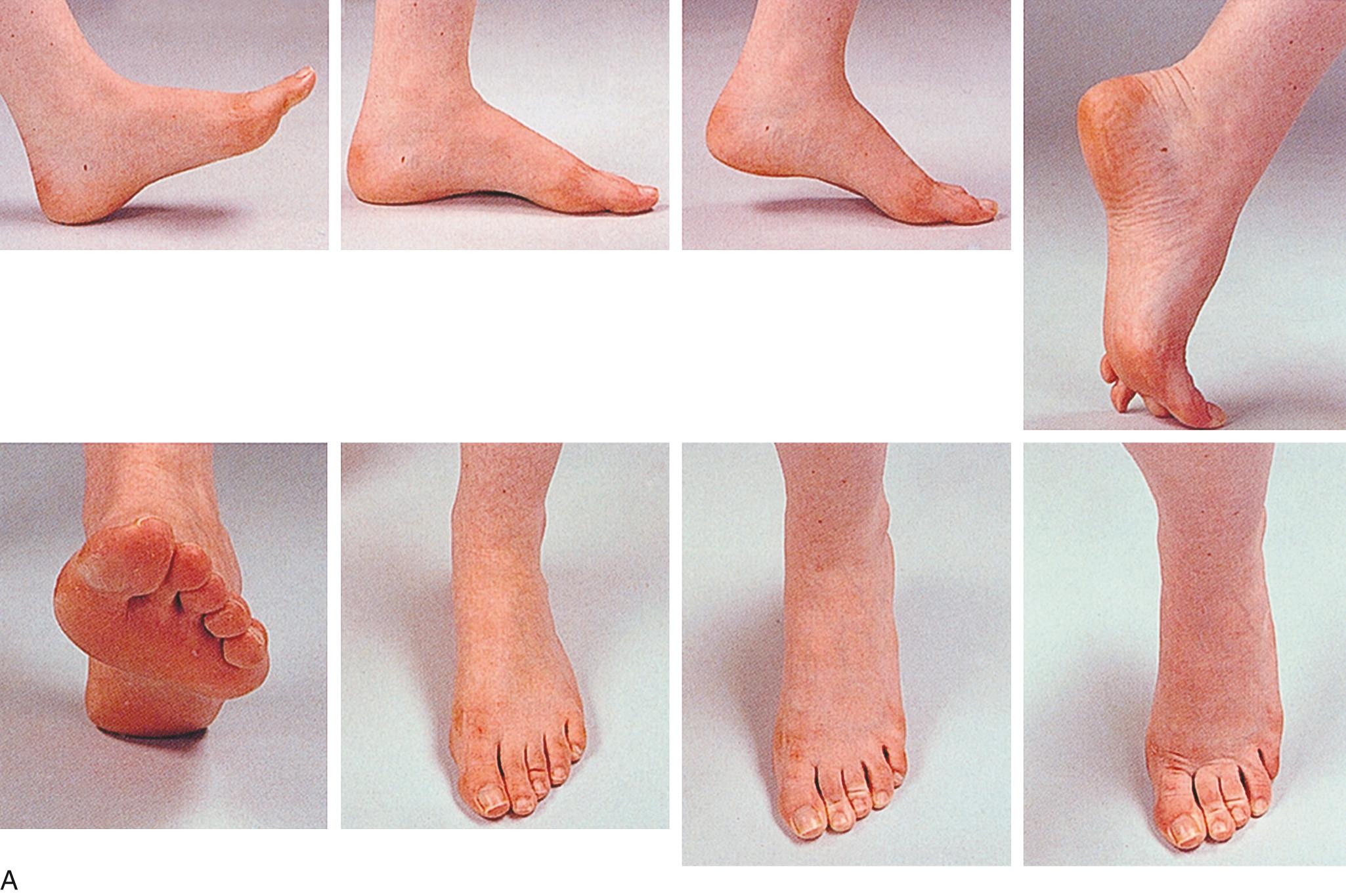
Observe the rate, rhythm, and arm motion used in walking. Does the patient have a staggering gait? Are the feet lifted high and slapped downward firmly? Does the patient walk with an extended leg that is swung laterally during walking? Are the steps short and shuffling? A complete discussion of gait abnormalities can be found in Chapter 21 , The Nervous System. Fig. 21.60 illustrates common gait abnormalities.
Attention should then focus on the spine to detect any abnormal spinal curvatures. Have the patient stand erect, and stand at the patient's side to inspect the profile of the patient's spine. Are the cervical, thoracic, and lumbar curves normal?
Move to inspect the patient's back. What is the level of the iliac crests? A difference may result from a leg length inequality, scoliosis, or flexion deformity of the hip. An imaginary line extending from the posterior occipital tuberosity should run over the intergluteal cleft. Any lateral curvature is abnormal. Fig. 20.24 illustrates this point. Fig. 20.25A shows severe kyphoscoliosis. See Fig. 13.6 .
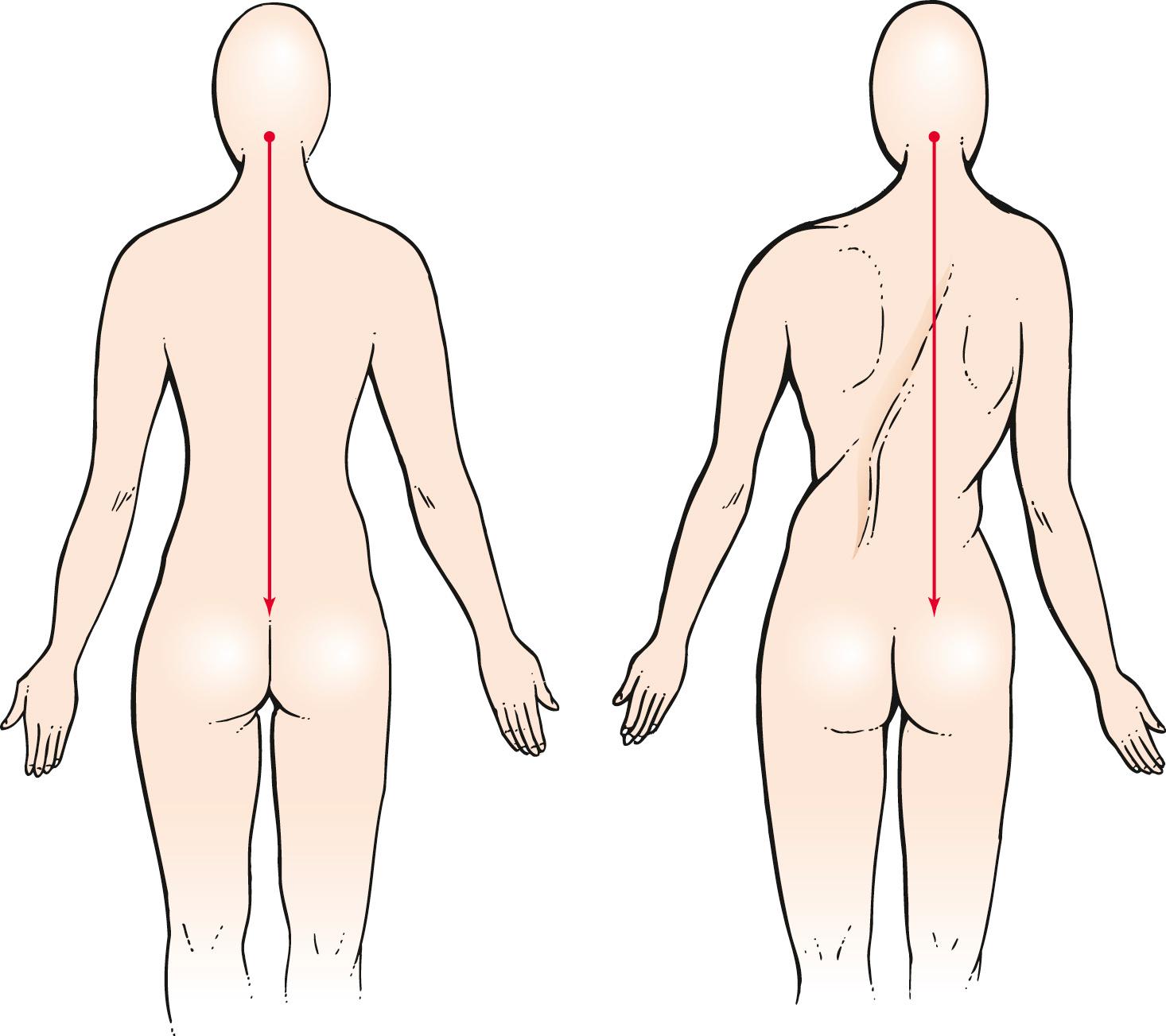
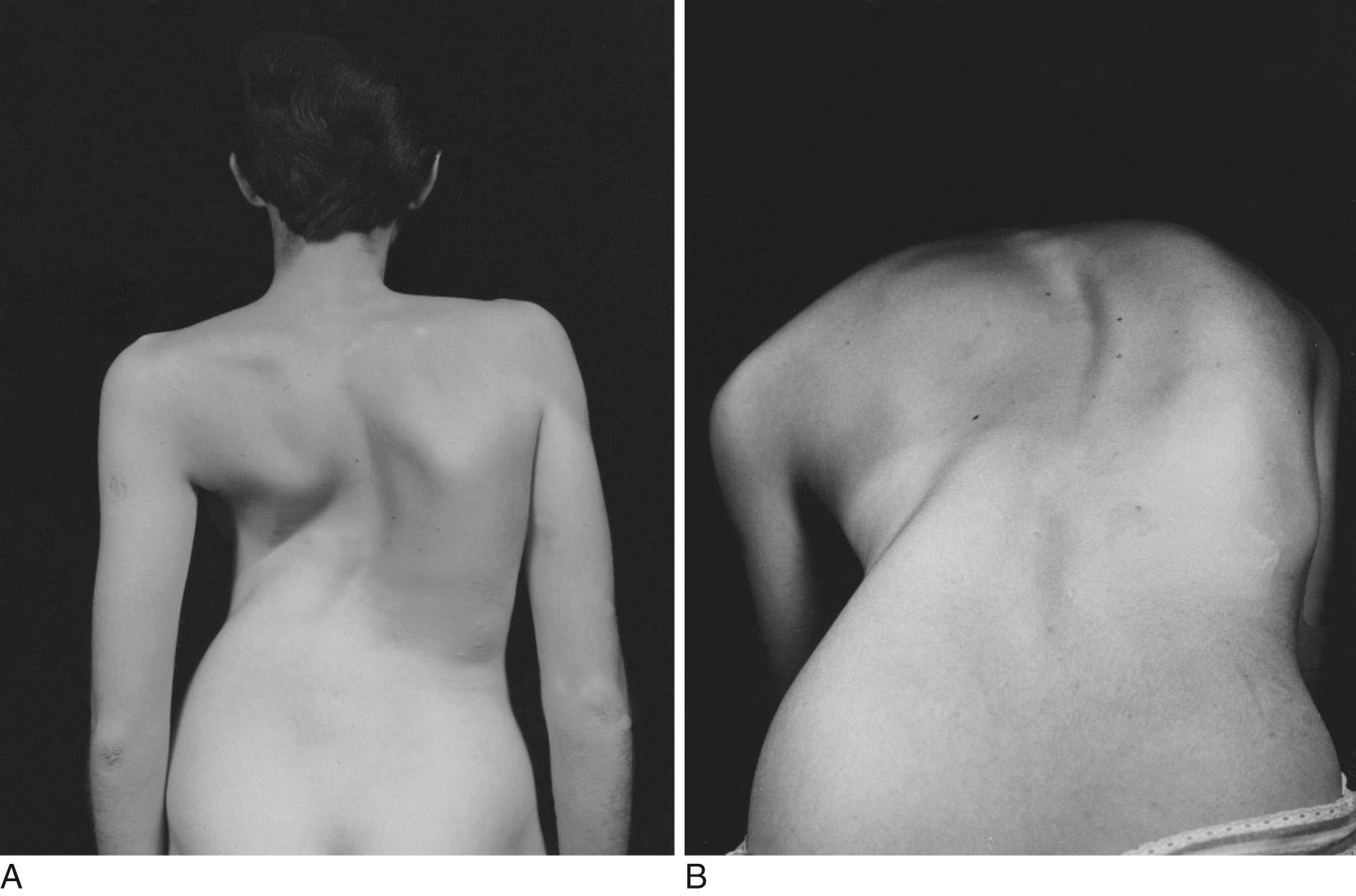
Ask the patient to bend forward, flexing at the trunk as far as possible with the knees extended. Note the smoothness of this action. This position is best for determining whether scoliosis is present. As the patient bends forward, the lumbar concavity should flatten. Fig. 20.25B shows the patient in Fig. 20.25A when bending forward.
Ask the patient to bend to each side from the waist and then bend backward from the waist to test extension of the spine, as shown in Fig. 20.26A .
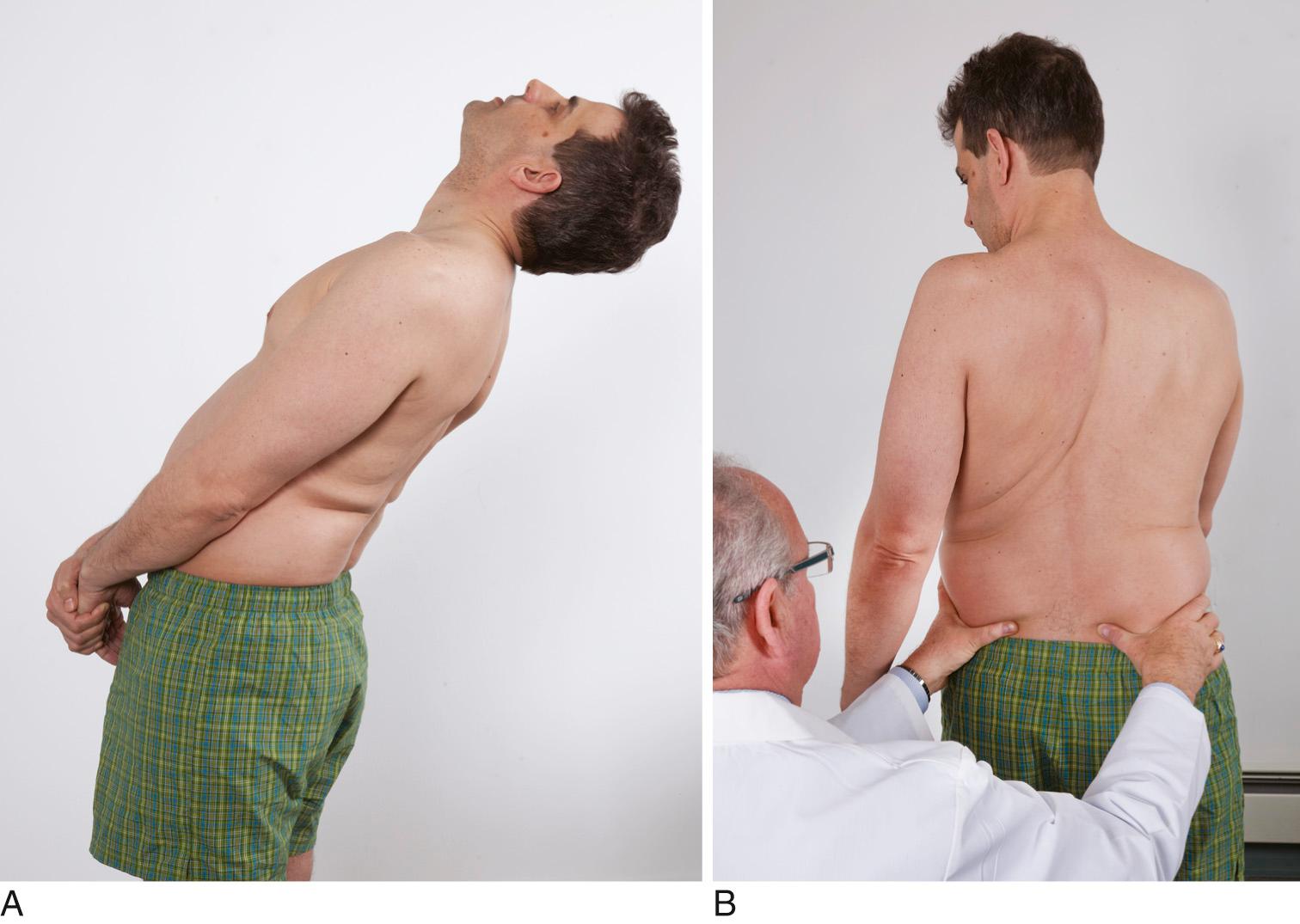
To test rotation of the lumbar spine, sit on a stool behind the patient and stabilize the patient's hips by placing your hands on them. Ask the patient to rotate the shoulders one way and then reverse, as shown in Fig. 20.26B .
To assess the function of all major joints of the lower extremities, stand in front of the patient. Have the patient squat, with knees and hips fully flexed. Assist the patient by holding his or her hands to secure balance. This is shown in Fig. 20.27 . Ask the patient to stand. Observing the manner in which the patient squats and then stands provides an excellent impression of the muscle strength and joint action of the lower extremities.
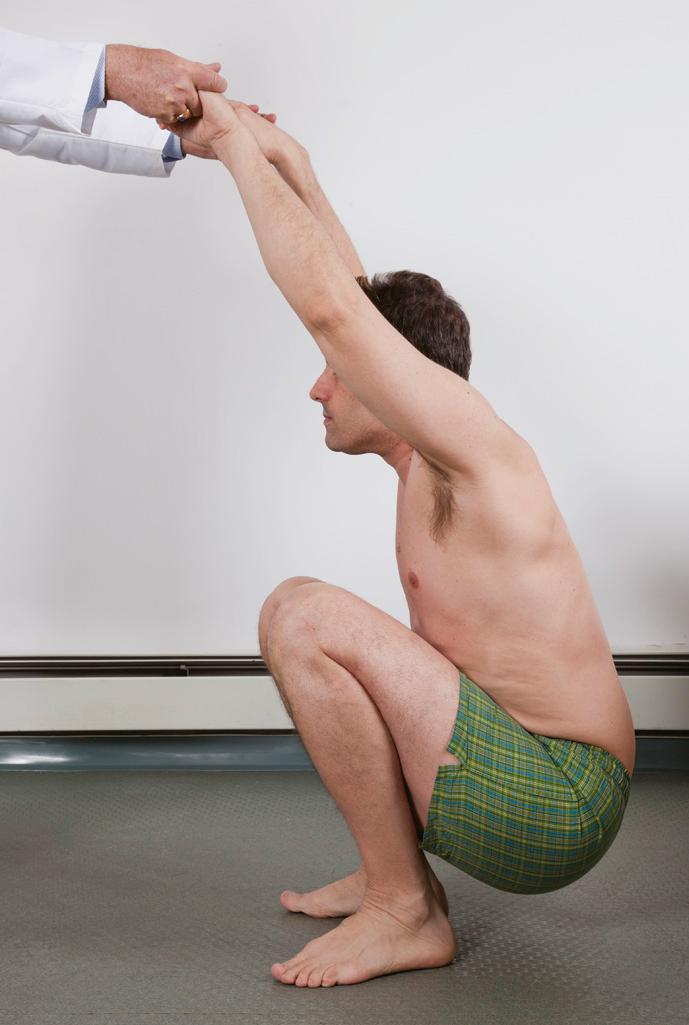
In addition, assessment of specific muscle groups can be performed and integrated into the arthrometric examination. Muscle strength can be graded according to the scale described in Chapter 21 , “The Nervous System.”
Measure the dorsiflexors and plantar flexors. With the patient seated, have the patient dorsiflex and plantarflex the foot against resistance. This can also be accomplished by asking the patient to walk toward and away from you on the heels and then on the toes. Injury to the common peroneal nerve causes weakness of the anterior muscle group, with a diminished capacity to dorsiflex the foot. Injury to the Achilles tendon or to the gastrocsoleus complex impairs plantar flexion.
Measure invertors and evertors. With the patient seated, have the patient invert and then evert the foot against resistance.
Measure the quadriceps and hamstrings. With the patient seated, have the patient extend and then flex the knee against resistance.
Measure hip abductors and adductors. With the patient seated, have the patient bring his or her knees together, then apart against the examiner's opposing force.
Measure the hip flexors and extensors. With the patient seated, have the patient raise the knee off the examination table against the examiner's downward, then upward, opposing force. Hip extensors can also be assessed by asking the patient to rise from a seated position unassisted.
Human immunodeficiency virus–related myopathy affects proximal muscle groups first, and patients may initially complain of difficulty rising from a chair or climbing stairs.
The patient is instructed to sit, and the range of motion of the neck is assessed. The patient is asked to put his or her chin on the chest, with the mouth closed, as shown in Fig. 20.28 . This tests full flexion of the neck.
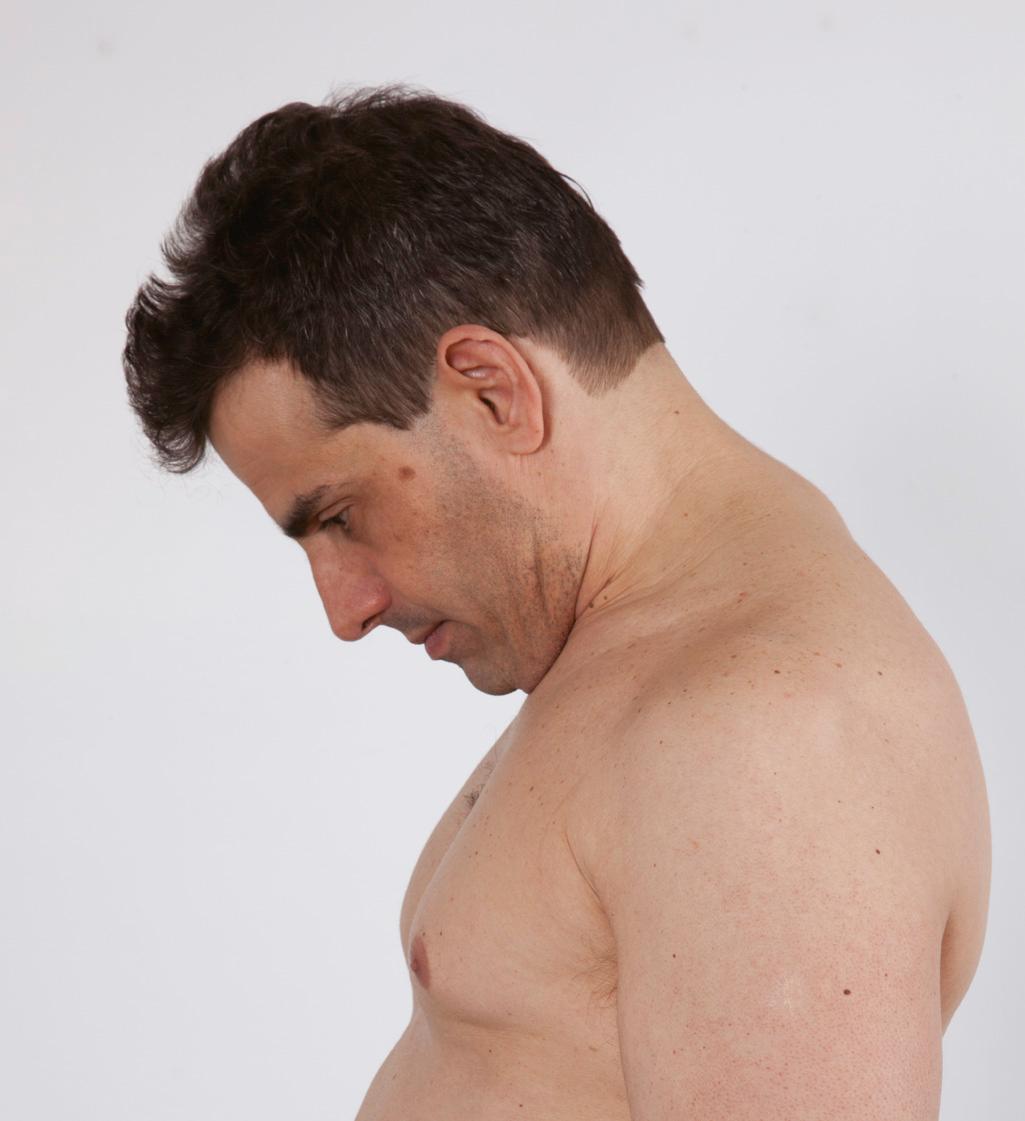
To test full extension of the neck, place your hand between the patient's occiput and spinous processes of C7. Instruct the patient to trap your hand by extending the neck. This is shown in Fig. 20.29 .
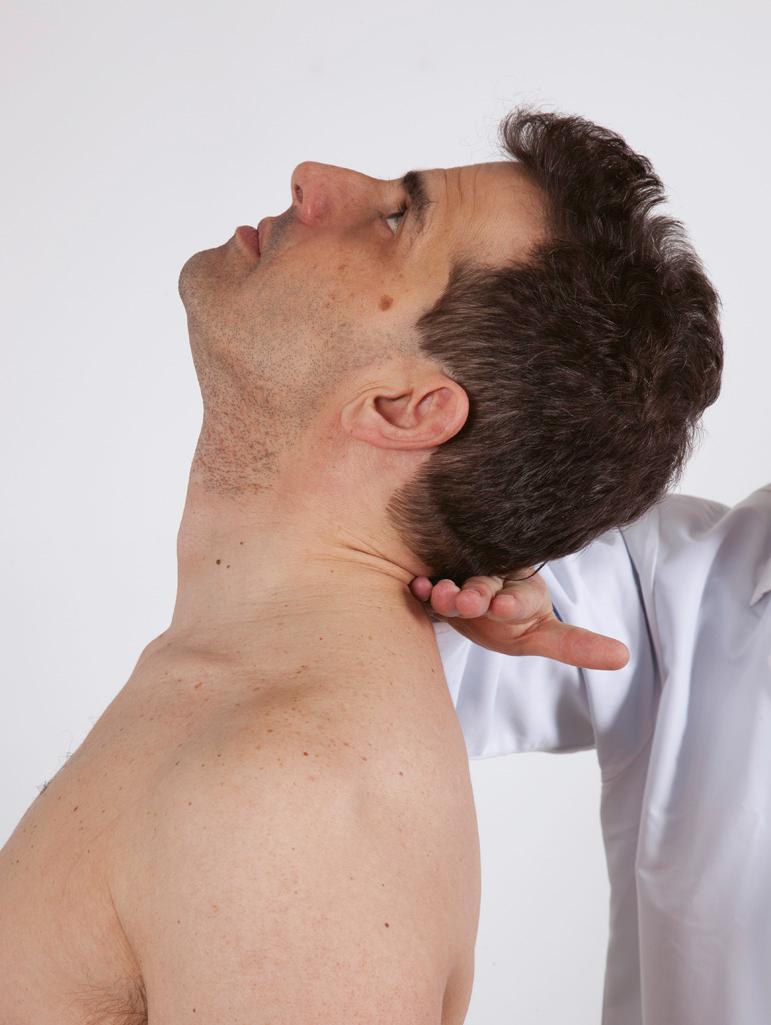
Evaluate rotation of the neck by asking the patient to rotate the neck to one side and touch chin to shoulder. This is shown in Fig. 20.30 . The examination is then repeated on the other side.
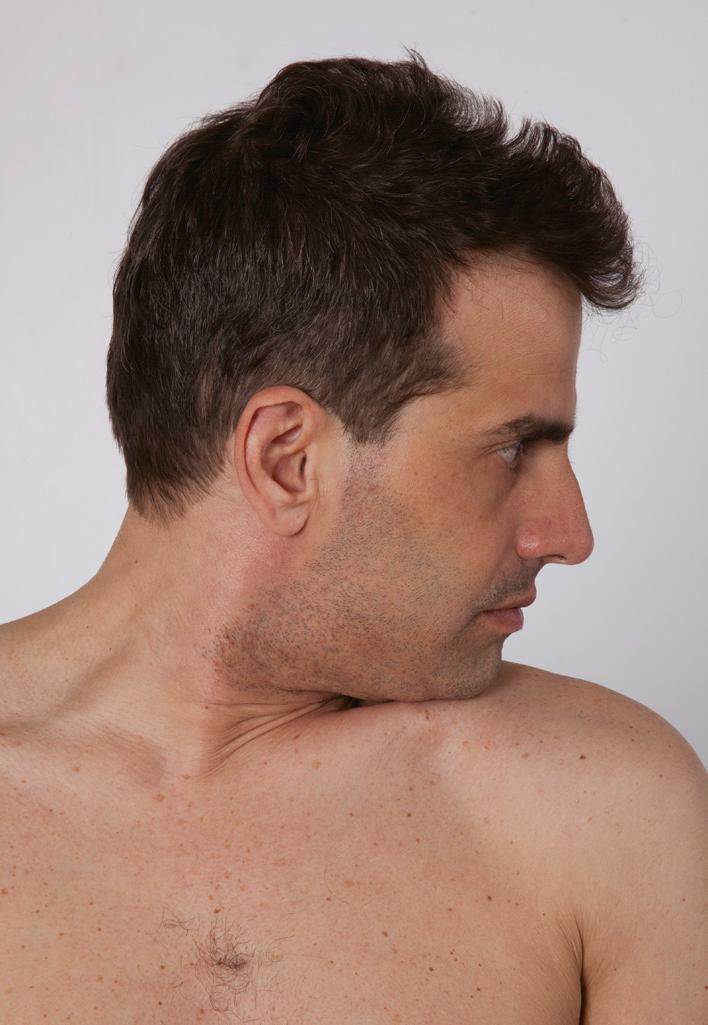
The patient is instructed to stretch out the arms, with the fingers spread. The examiner attempts to compress the fingers together against resistance, as shown in Fig. 20.31 . This tests the intrinsic muscles of the hands.
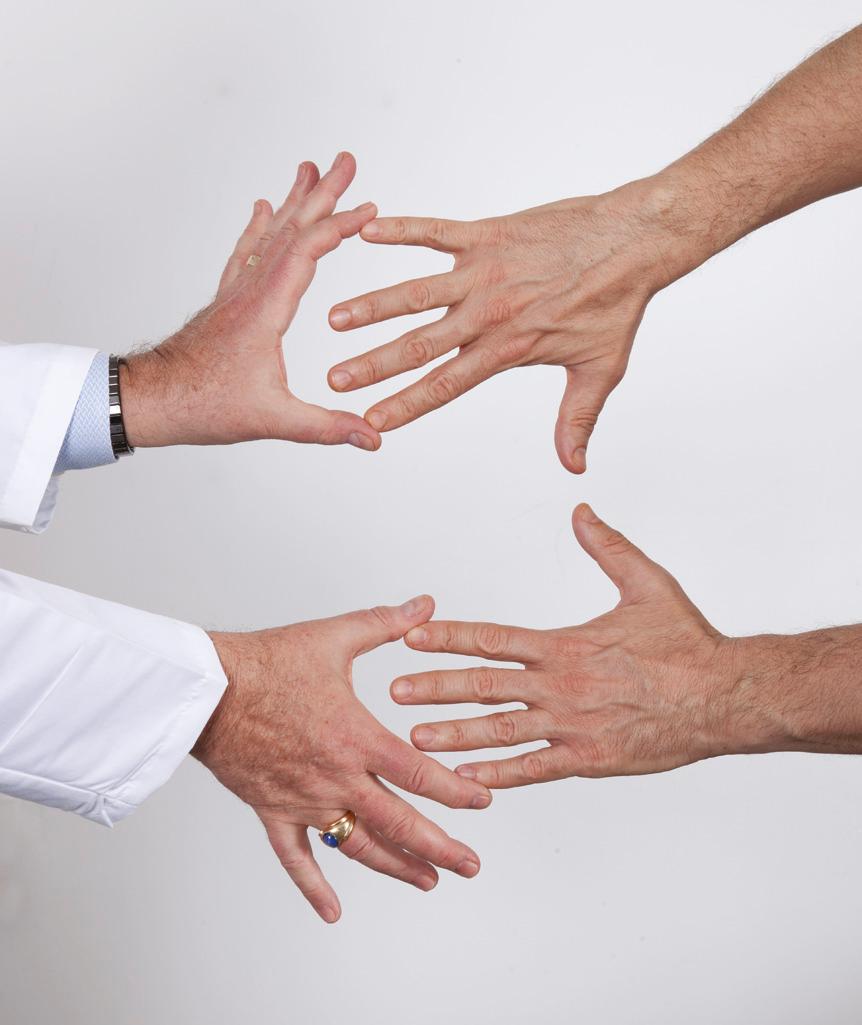
To test the functional range of rotation of the humerus and the shoulder, acromioclavicular (AC), and sternoclavicular joints, instruct the patient to abduct the arms fully and place the palms together above the head. The arms should touch the patient's ears with the head and cervical spine in the vertical position. This is shown in Fig. 20.32 .
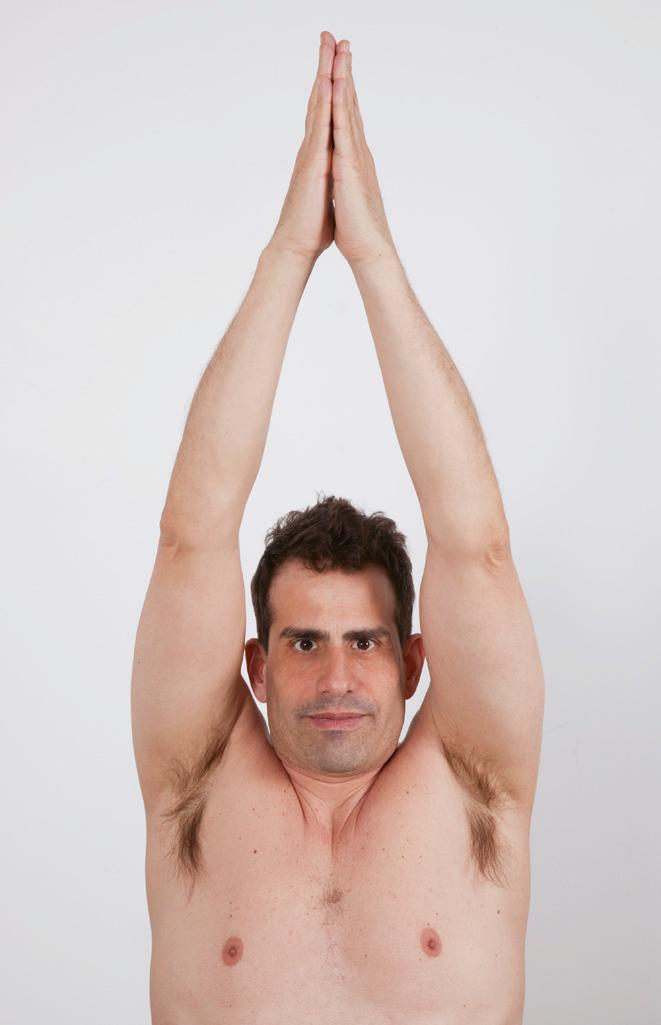
Become a Clinical Tree membership for Full access and enjoy Unlimited articles
If you are a member. Log in here